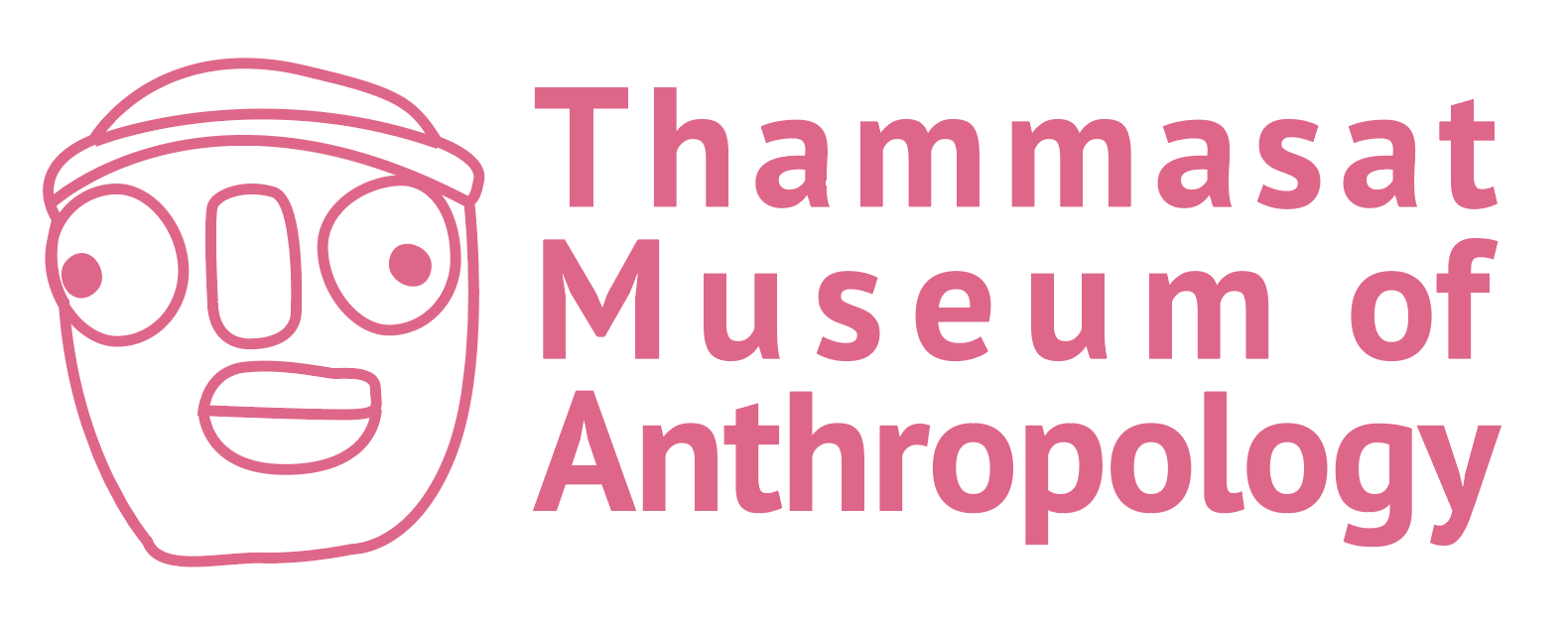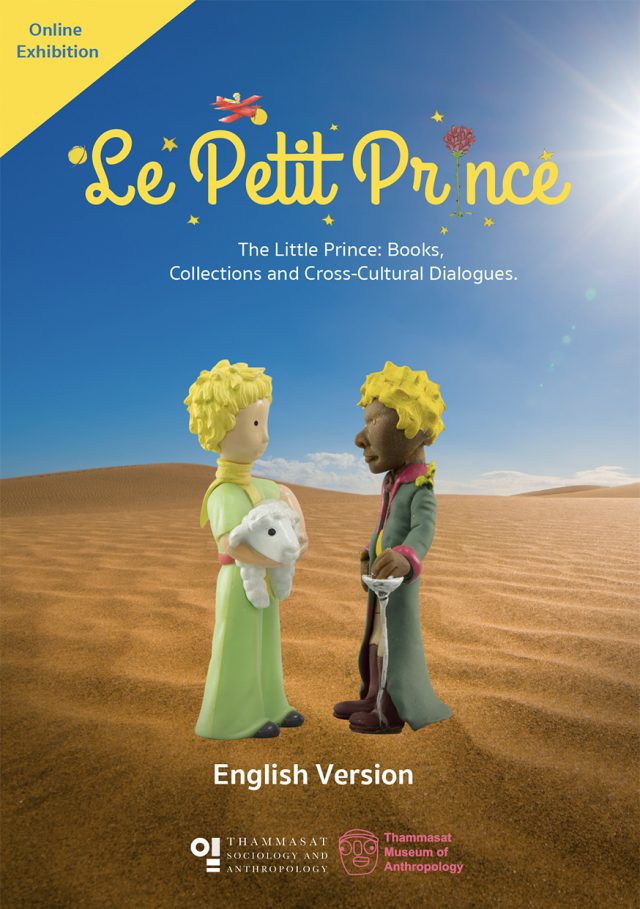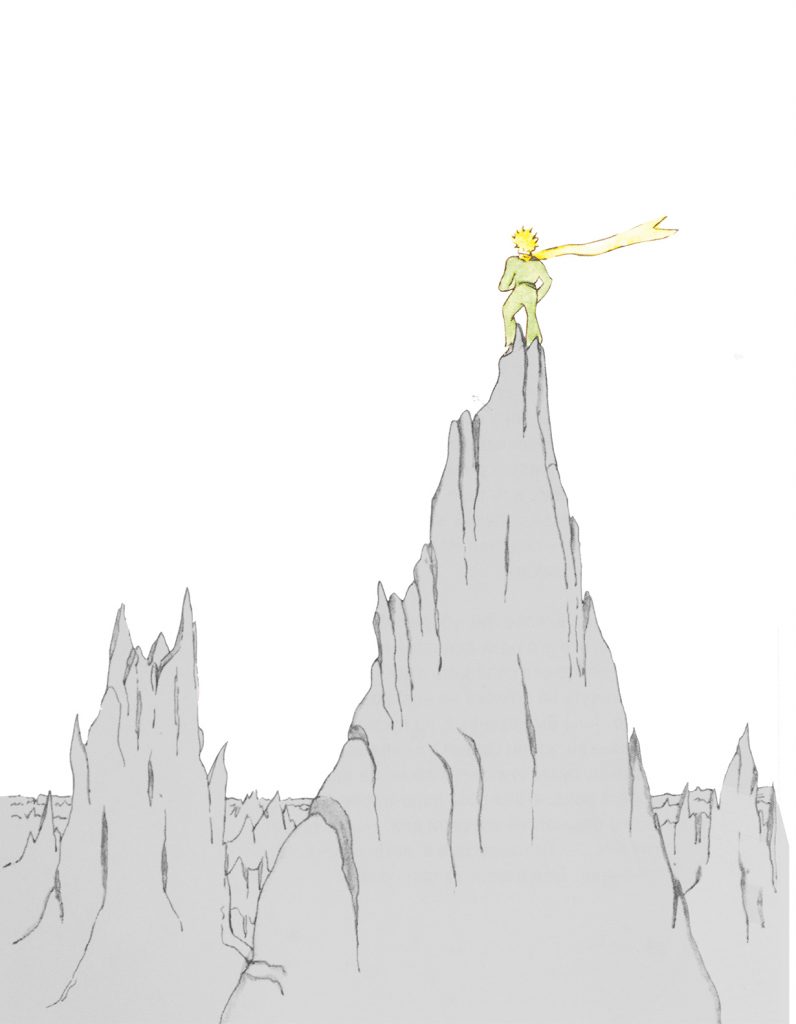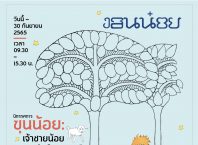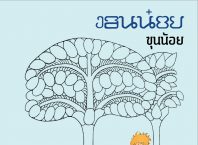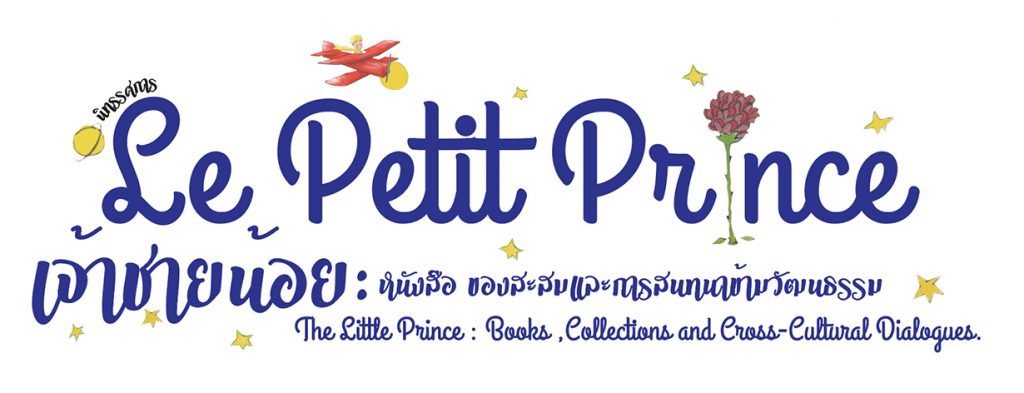
77 Years of The Little Prince (1943-2020)
The Little Prince has been translated into more than 380 languages amongst 62 countries, making this novella (short novel) the second-most translated in the world after the Bible.
After the first publication in English and French in 1943, the novella was translated into Polish in 1947. Thereafter it was translated into other languages amongst countries in western and northern Europe, followed by translations into languages of African, Asian and eastern European countries
The translation of The Little Prince into different languages across the world (including translations through piracy and under inappropriate request for permission) must, on one hand, have been by the virtue of its illustrations and content, which contain mysterious charm throughout. On the other hand, it must have owed to the national pride of the language of each of the countries involved in the translation. The extensive translation of The Little Prince therefore stems from ‘the positive print capitalism and piracy’, which are tightly intertwined with nationalism and internationalism.


77 years of the Little Prince, 120 years of the author, and the 120th year for the discovery of planet B 612
The Little Prince (Le Petit Prince) is a French literature written in the USA by a French author, Antoine de Saint-Exupéry. It was first published in French and English in the USA in 1943, and posthumously in France in 1946, following the liberation of France from Germany.
The Little Prince is a story about friendship, relationship, responsibility, quest, discovery, faith and human existence. The Little Prince is like a small flower-tree, born and bloomed out of the ruins of World War II.
The story of The Little Prince has been widely known through translations of many different languages. It has been adapted for film, animation, theatre, music, fashion and museums, as well as objects of personal collections. It has also inspired the development of public sections and organizations such as those for children rights, health, education, culture, environment, aviation, and astronomy.
The exhibition The Little Prince: Books, Collections and Cross-Cultural Dialogue presents the life and work of the author, the contents of the book through translations, and the display of collections. It also creates new dialogues through cultural encounters and role of museums in the contemporary world.
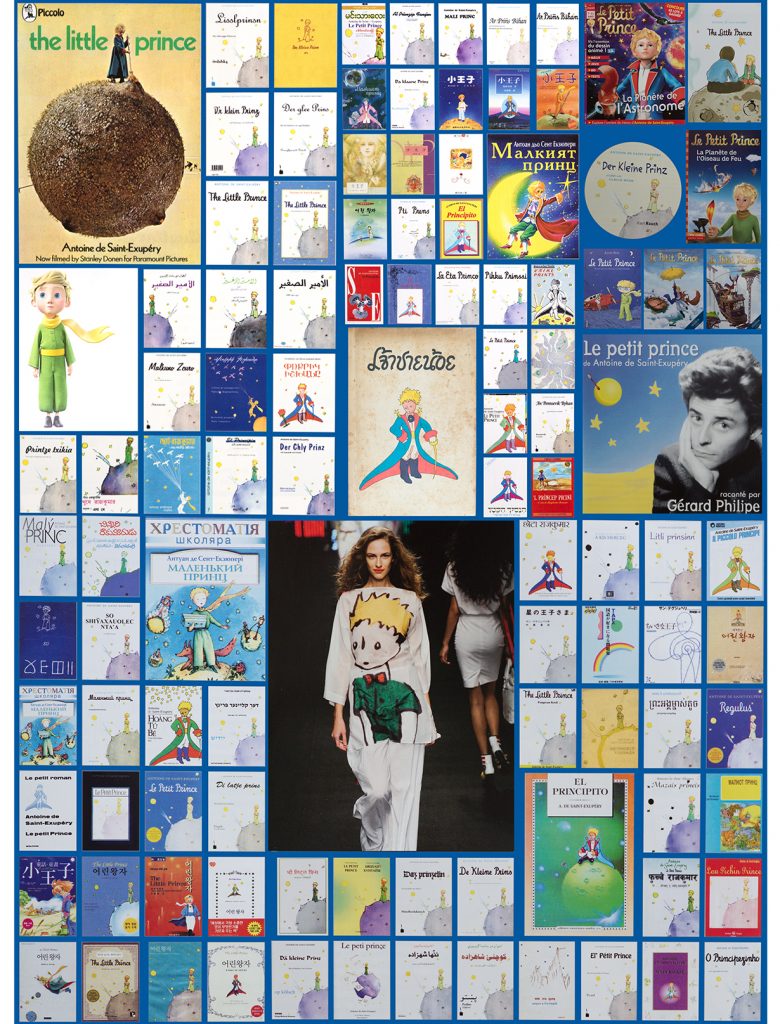
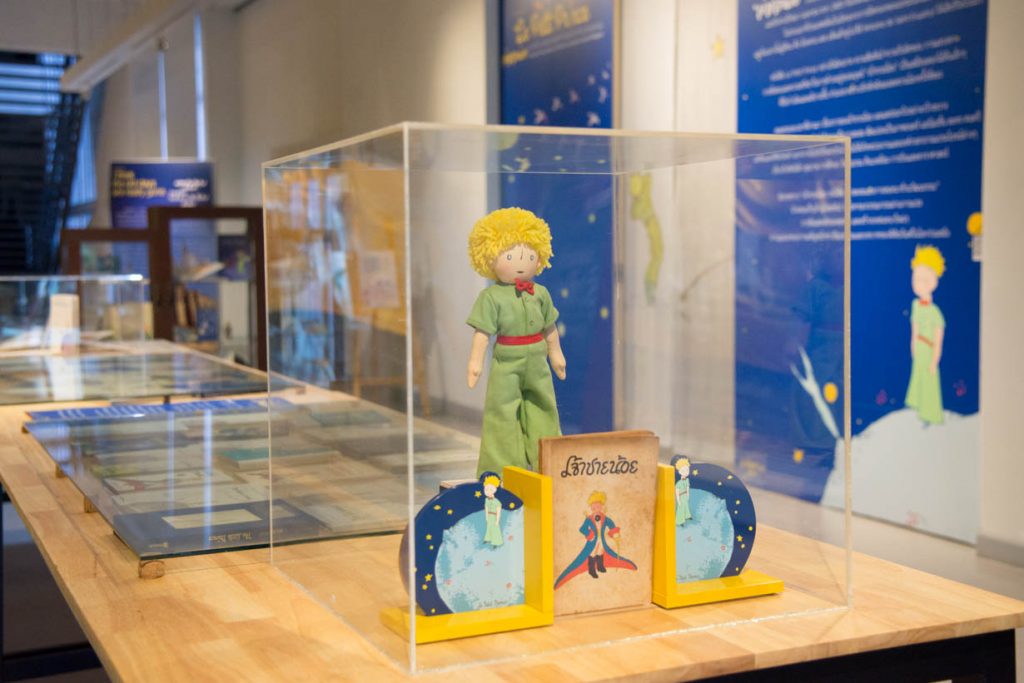
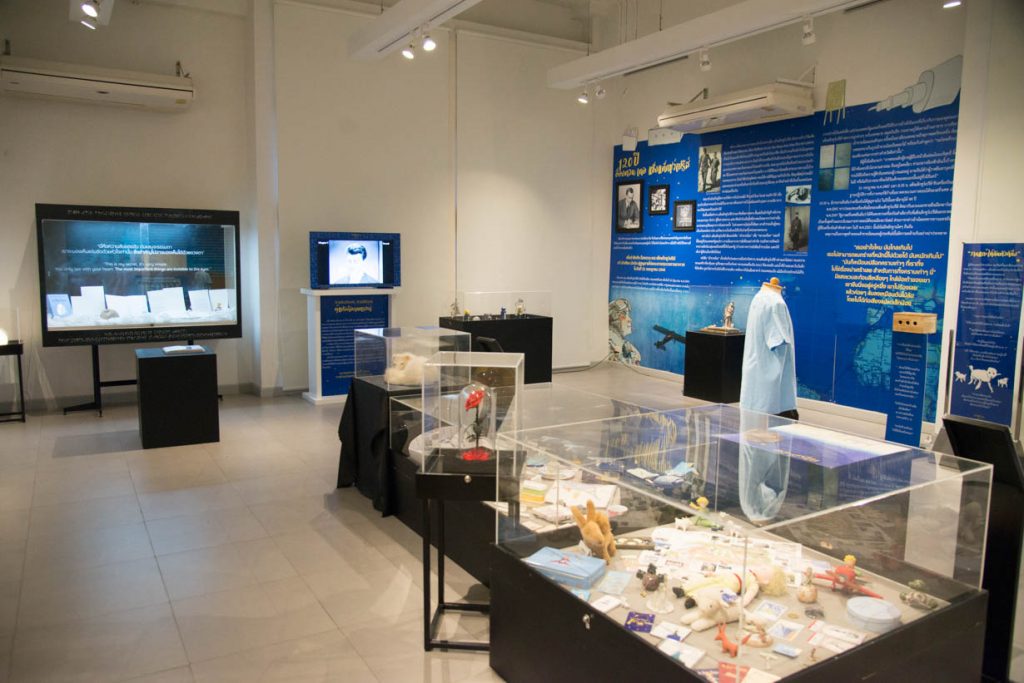
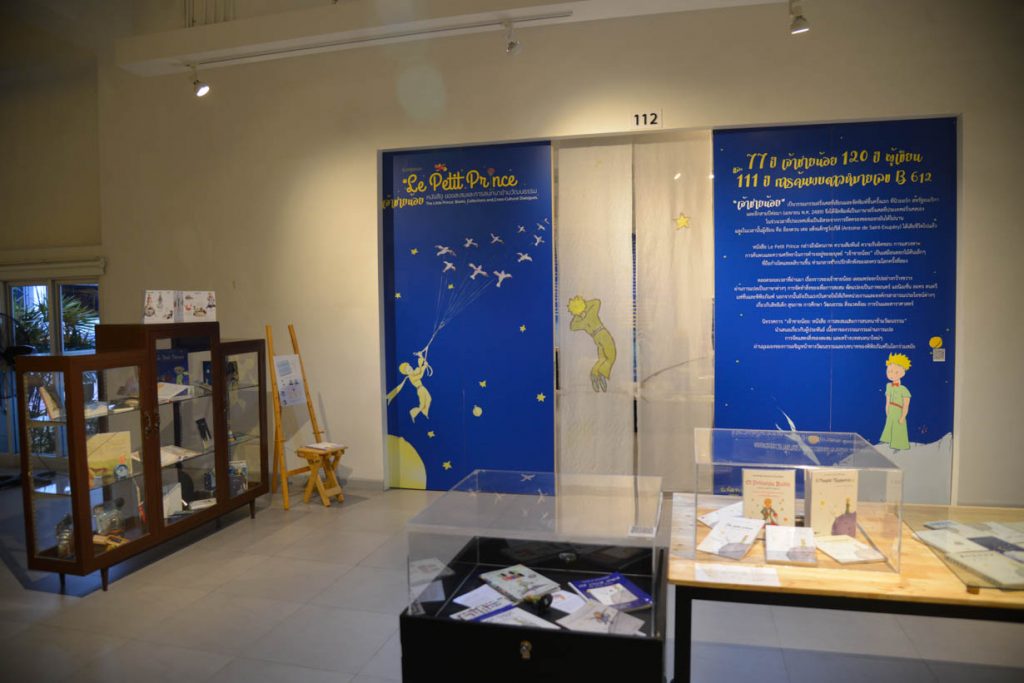
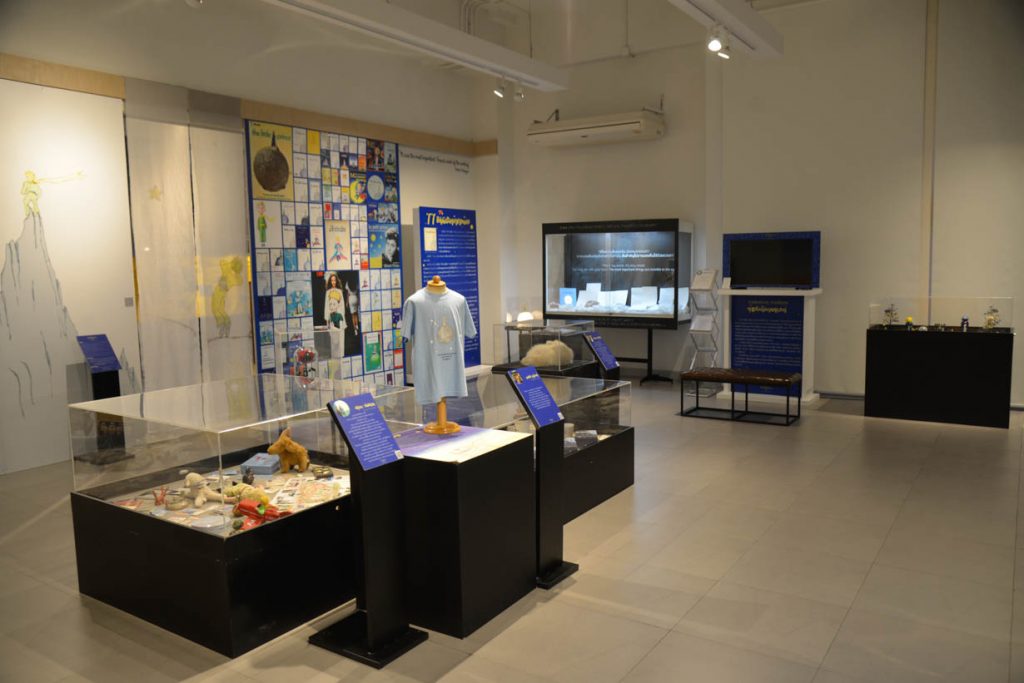
77 years of The Little Prince
The Little Prince / Le Petit Prince has a rather peculiar history. The book was composed and first published (by Reynal & Hitchcock Publishing Company) in New York during World War II, when the author, Antoine Saint-Exupéry, was seeking refuge there and France was under siege by Nazi Germany.
The English version, The Little Prince, was first launched on 6 April 1943. A few days later, a small number in the French version, Le Petit Prince, was then published.
It was three years later that Le Petit Prince was published in France. A number of details in the illustrations published in France differ from those published in the US. For example, the roots of the Baobab tree in the English version show more details, while the green colour of Little Prince’s shawl was turned blue and the comet seen by the Turkish astronomer does not exist in the edition published in France. Also, the number of the setting sun on the Little Prince’s comet has gone to 43 instead of 44 as was in the first edition.
It took 58 years before Le Petit Prince was published in the original version of contents and illustrations in France.
Different opinions exist as to whether The Little Prince is a book for children or grown-ups for it is embedded with philosophical elements. Some say the book brings to mind Hans Christian Andersen’s fairy tales, others say it resembles Montesquieu’s philosophy works.
The book was deeply fascinated by James Deans, an American actor who died at the age of 24 when his fame was at its peak. Martin Heidegger, a German philosopher, wrote in a preface to the German version of The Little Prince as being France’s ‘most important work of the century’.
The Little Prince is an iconotext, a category of books where texts and illustrations complement each other. One cannot isolate texts from illustrations and illustrations lead to better understanding of texts.
The Little Prince is the world’s fourth bestselling book after the Bible, Karl Marx’s Capital and J.K. Rowling’s Harry Potter, respectively. The book has been translated into Esperanto, Chinese, Hindi, and Spanish, including other widely spoken languages as well as local and endangered languages and dialects (for example, Aranese, the dialect spoken amongst some two-thousand inhabitants of Val d’Aran in northwestern Catalonia close to the Spanish border with France). The book was also translated into extinct languages (such as ancient Egyptian), invented writing system of modern day (such as Braille and Aurebesh, the latter features in the famous film series Star Wars), as well as Morse code (French).
Le Petit Prince was the only book the astronaut Philippe Perrin took with him to the space to read during his mission in the International Space Station (ISS) in 2002.
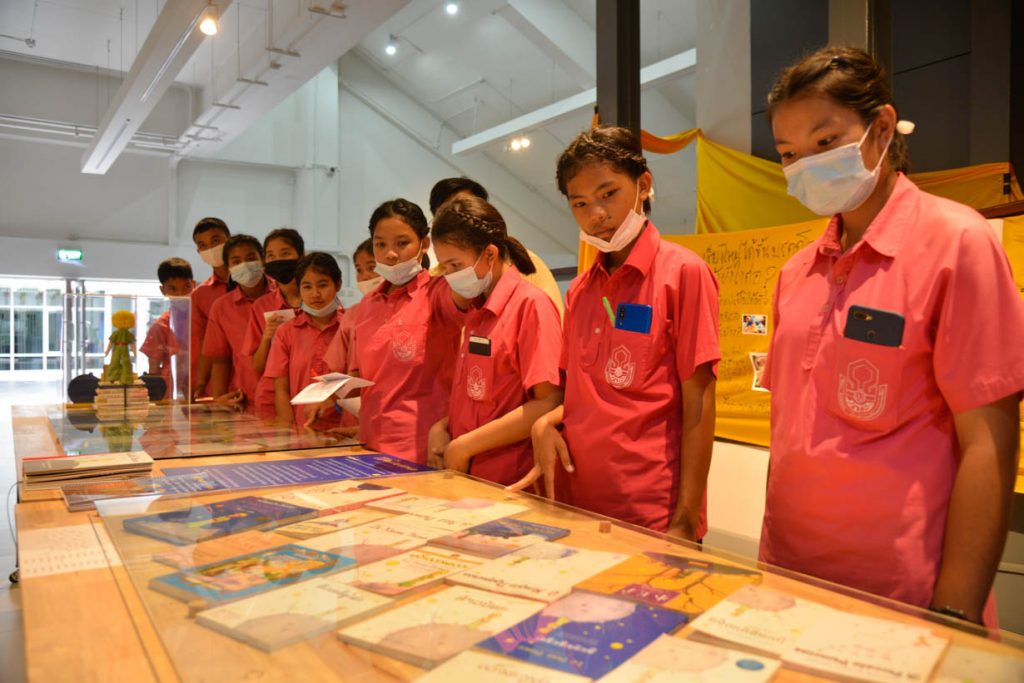
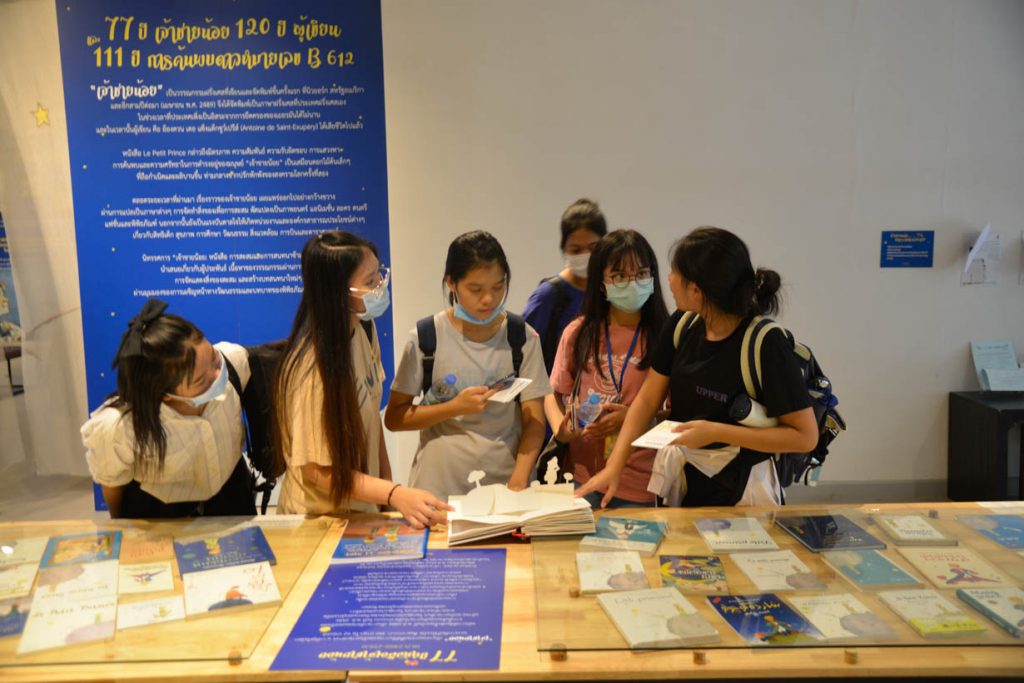
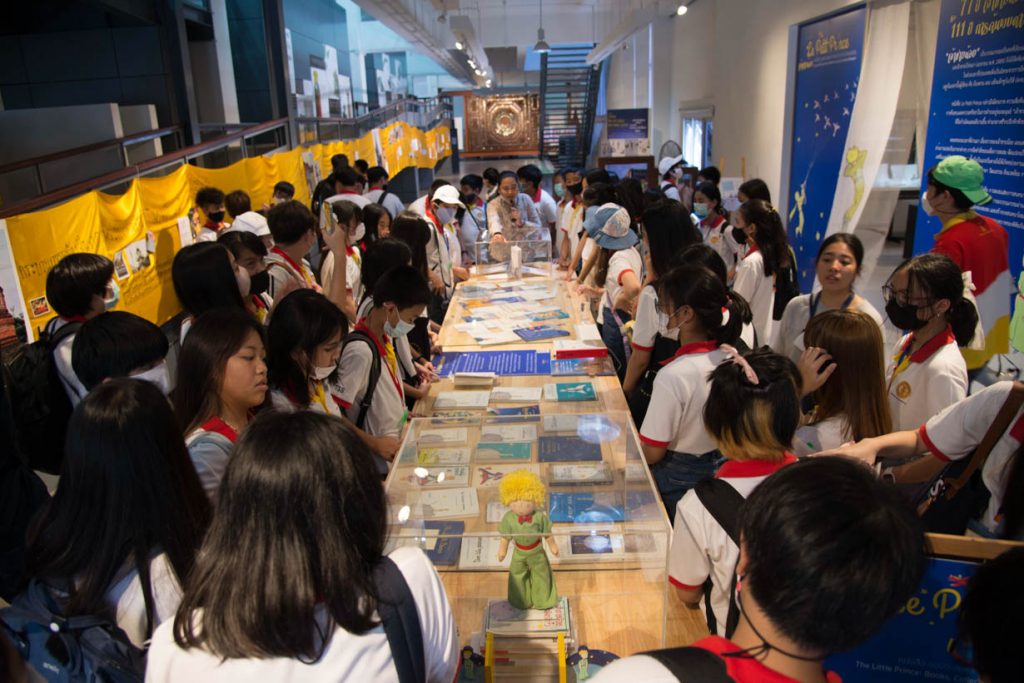
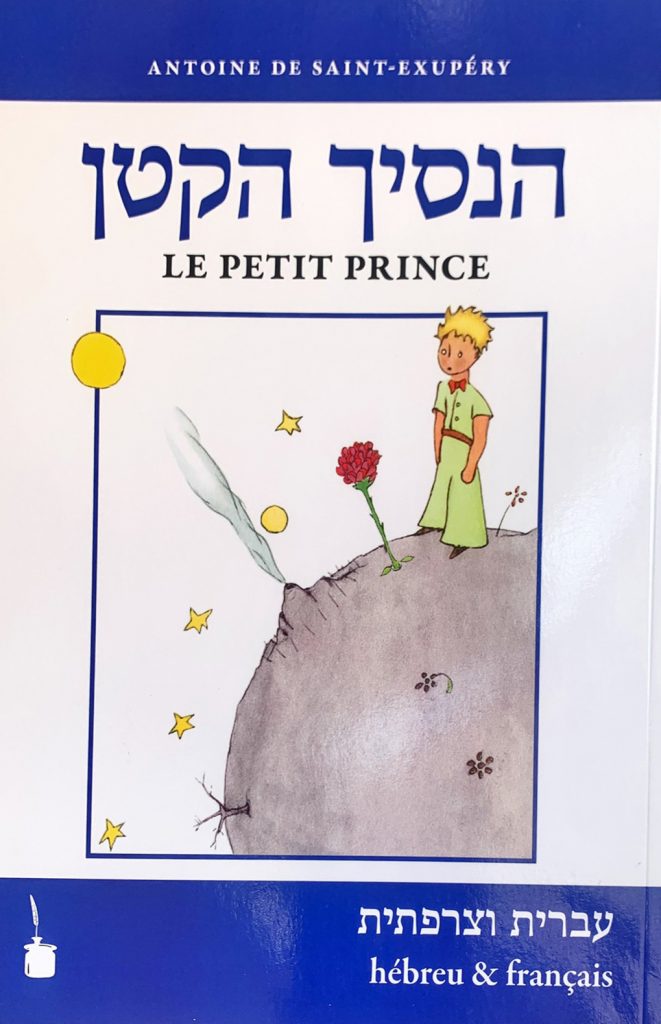
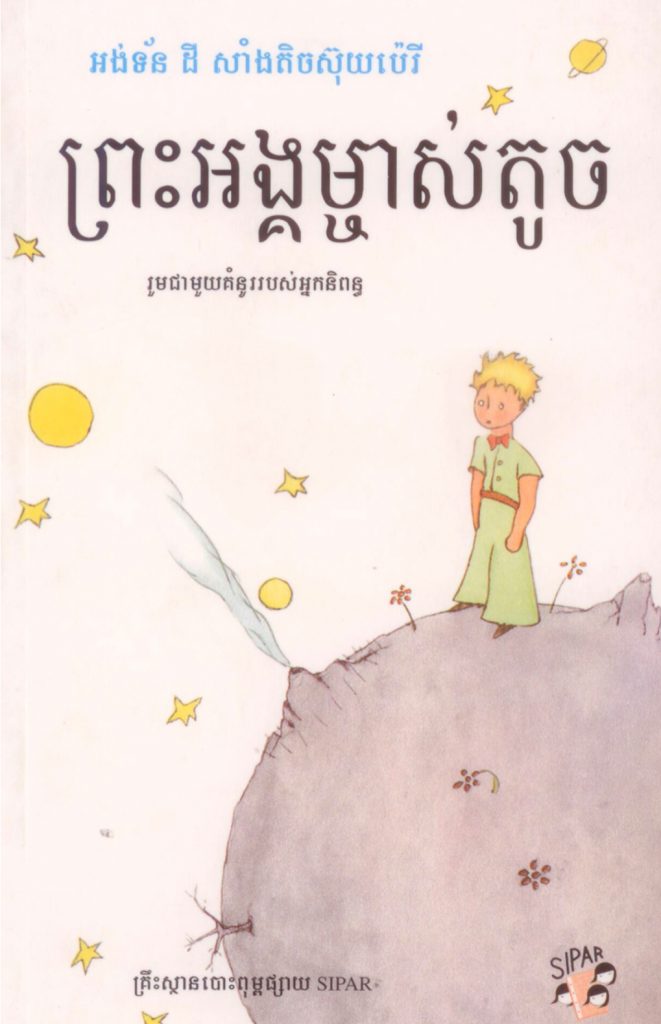
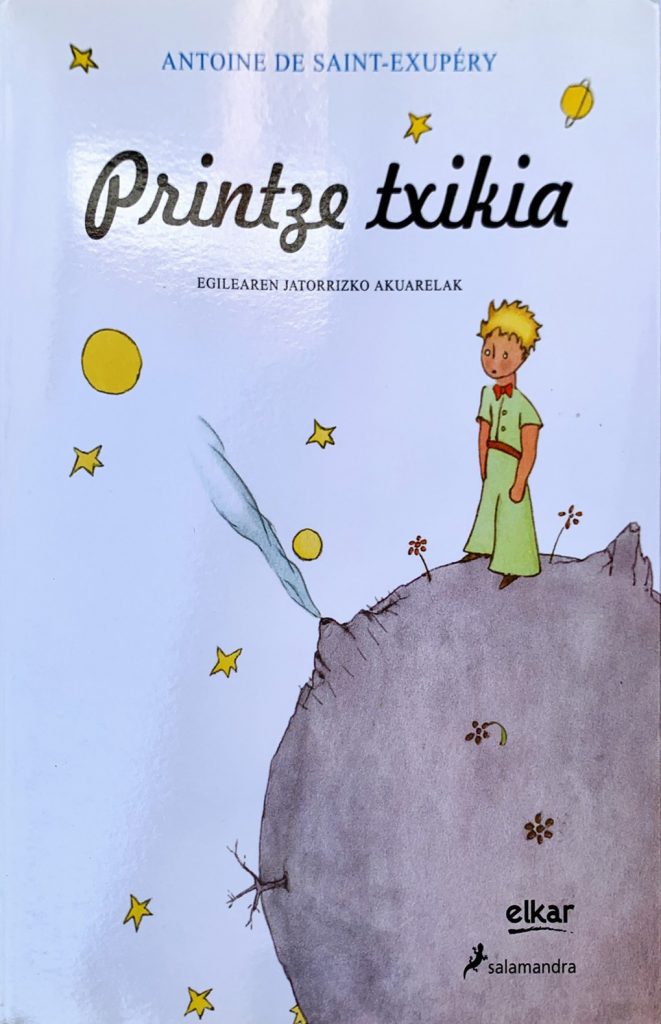
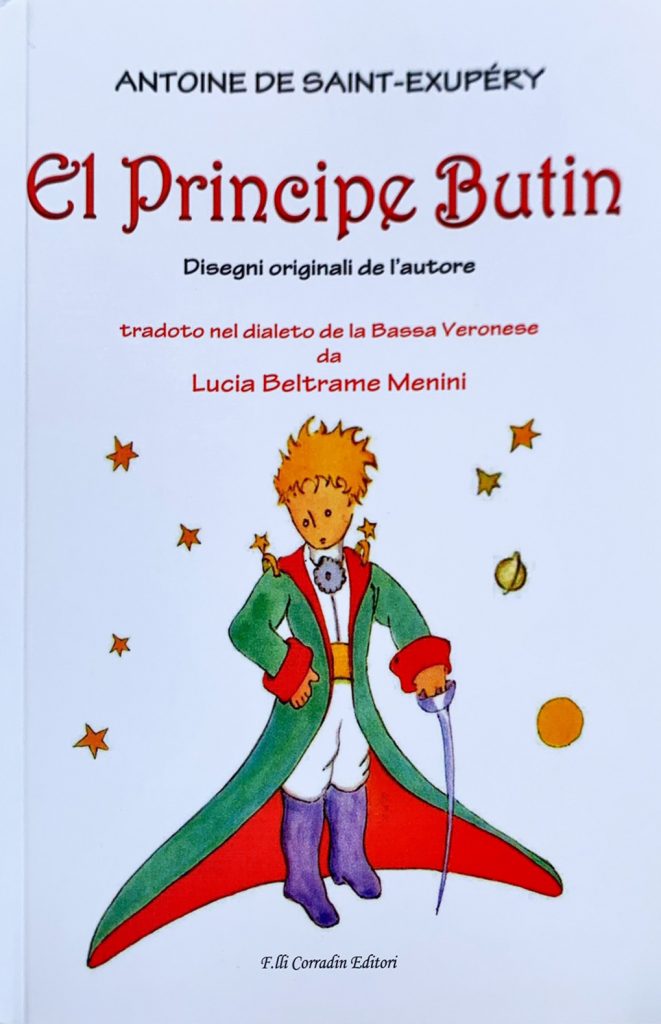

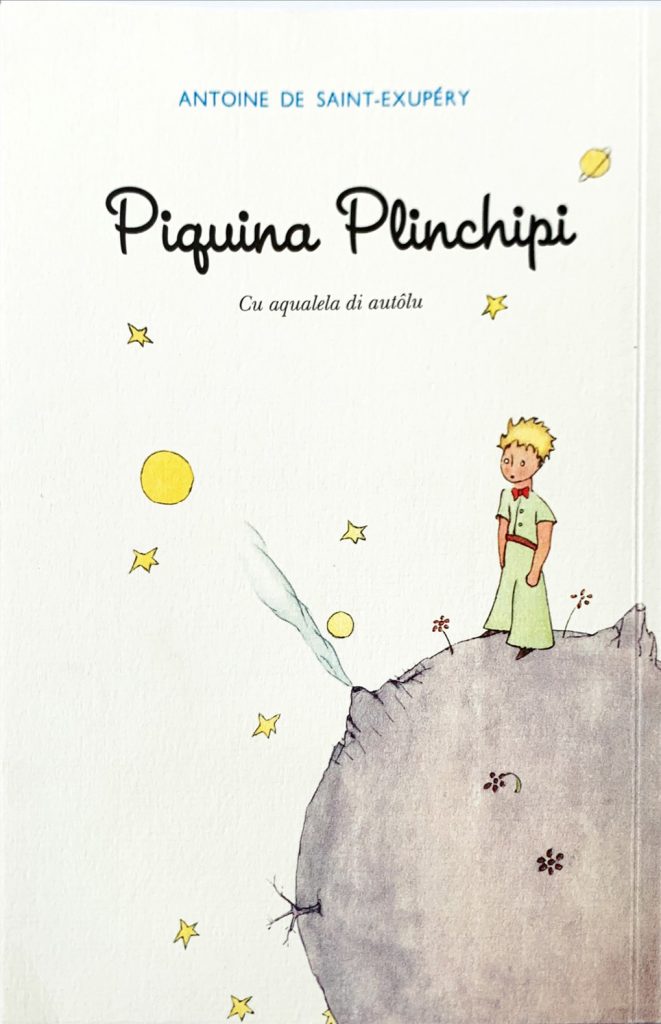
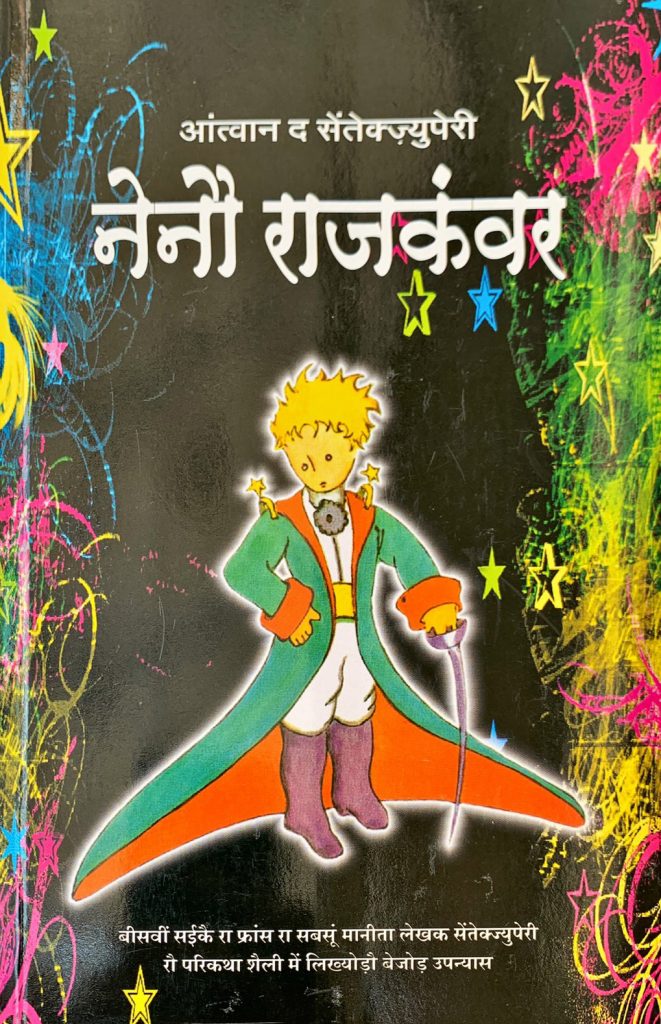
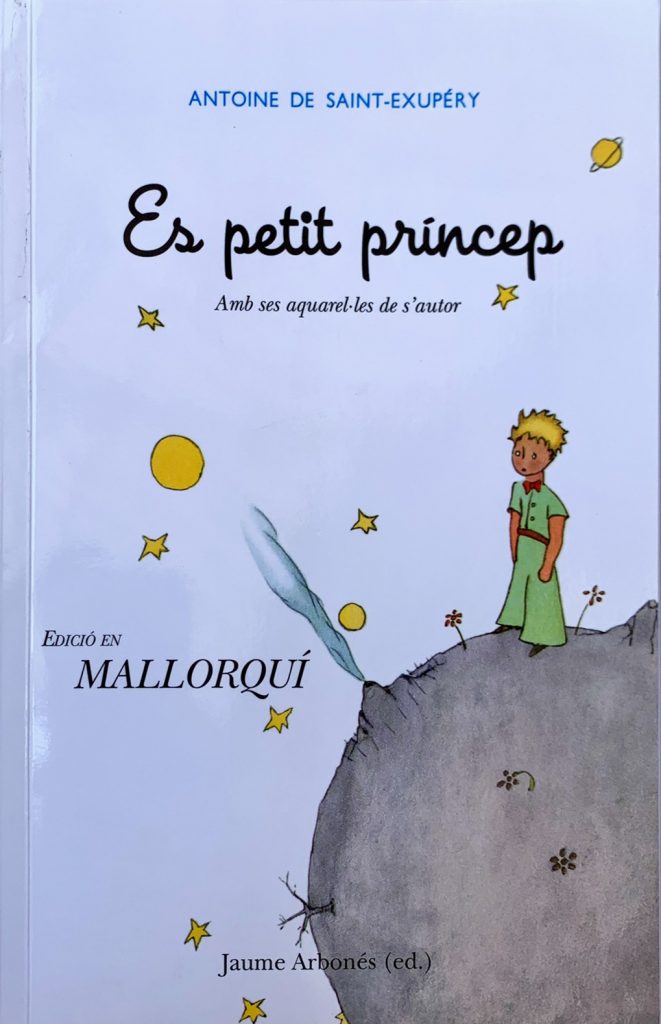
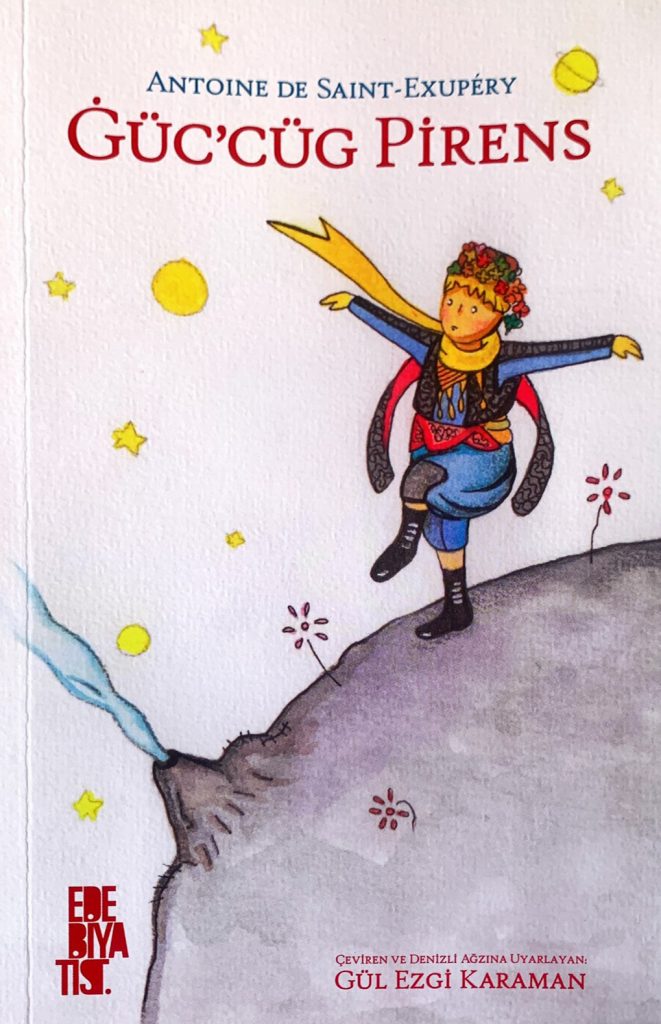
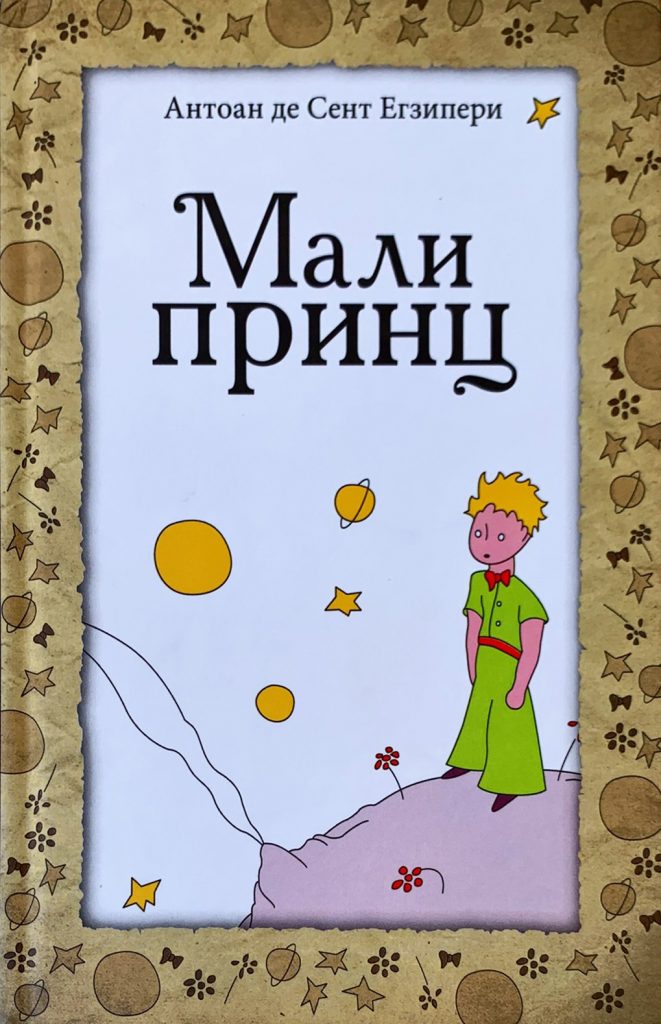
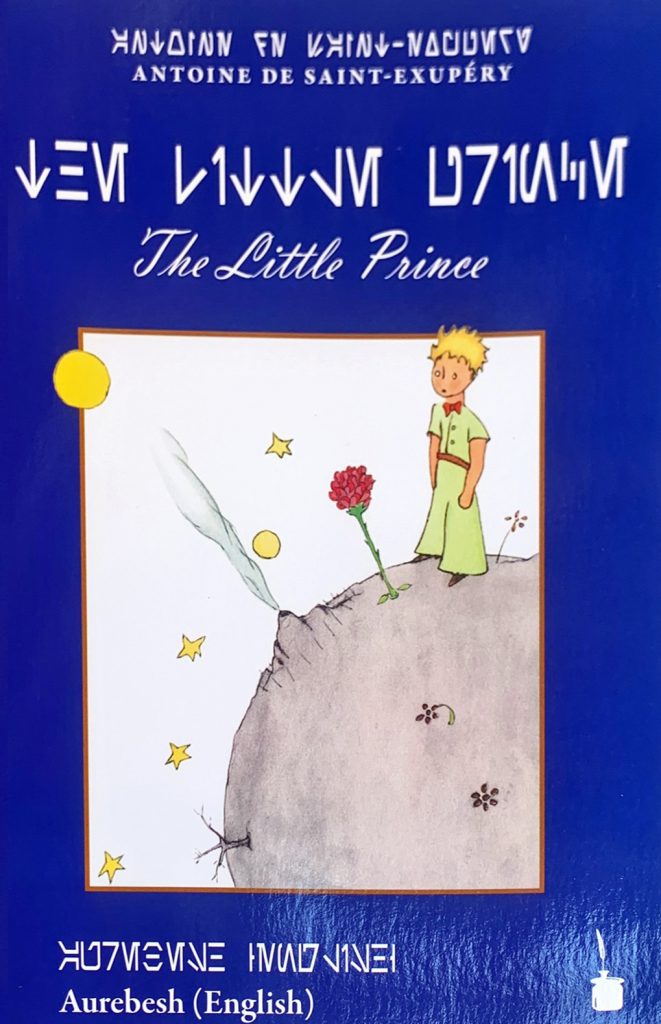
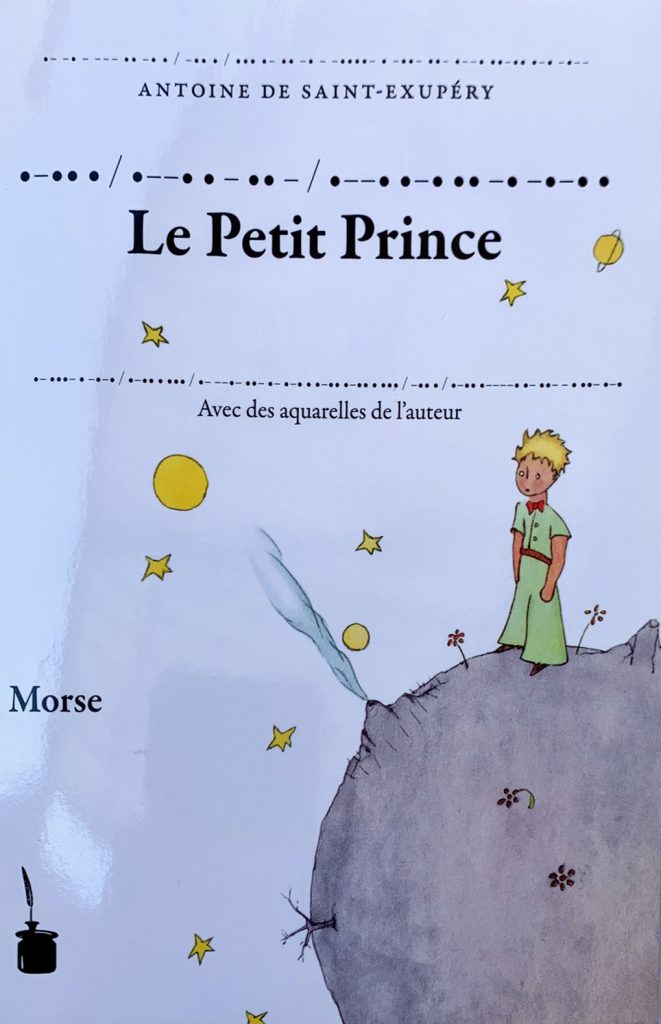
La lecture agrandit l'âme: Voltaire
120 Years of Antoine de Saint-Exupéry
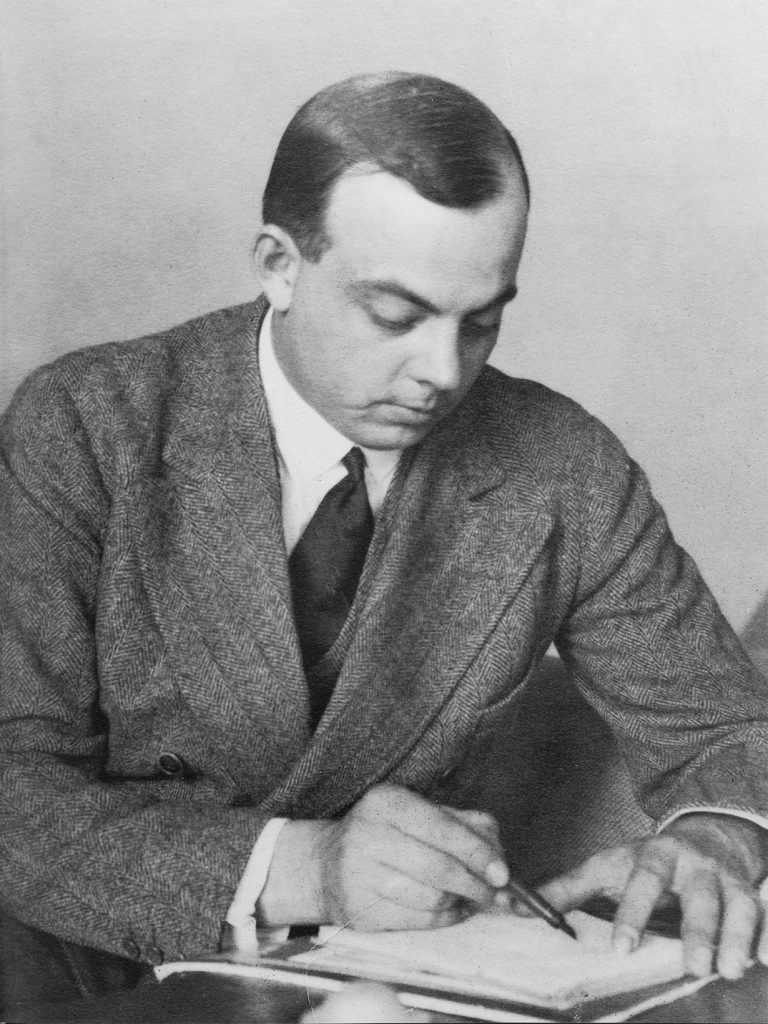
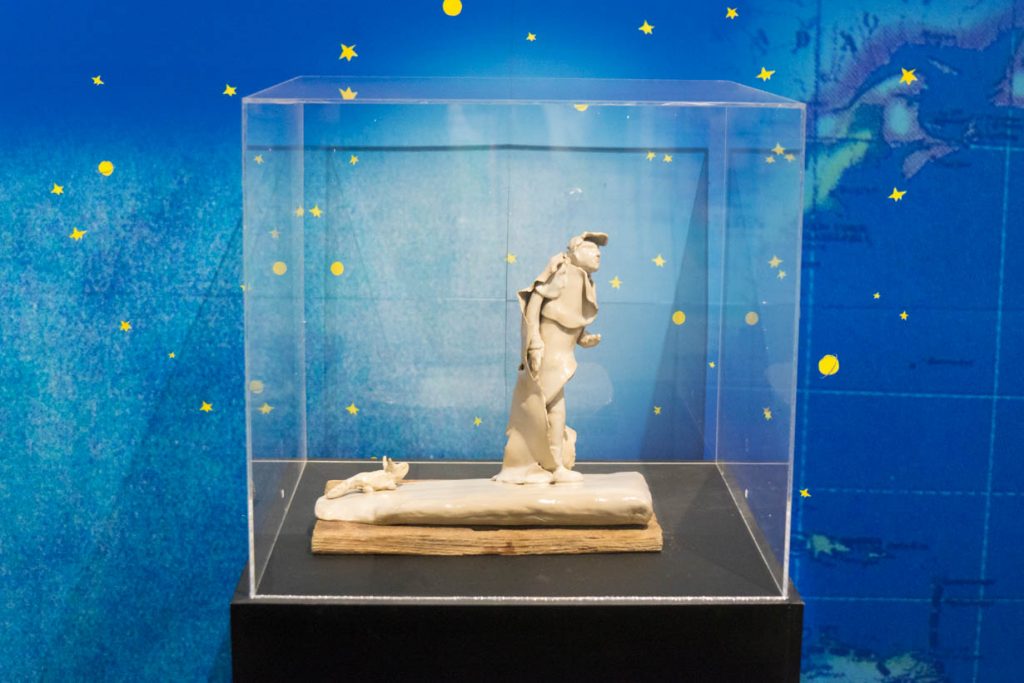
Antoine de Saint-Exupéry was born in Lyon, France, on 29 June 1900. His father died when he was four years old. In his childhood, Saint-Exupéry was fond of reading, painting, and playwriting. He was interested in and imagined for machines that could fly like birds. His first experience on an airplane was when he was 12 years old.
After failing the exam at a preparatory Naval Academy, Saint-Exupéry moved to Paris to study architecture at École des Beaux-Arts. He later on entered the military service where he received training in flying and became a pilot. His aviation career began when the international postal flight was at its outset. Saint-Exupéry’s task was to help pilots who faced problems during their flights in north-western Africa. He later became the airline stopover manager in the Spanish zone of South Morocco, in the Sahara Desert. Living in isolation in a desert, sending radio transmission and signals to pilots, arranging mailing pouch, and on search missions for downed flyers whom his duty was to rescue, Saint-Exupéry worked as a medical doctor as well as an aircraft engineer.
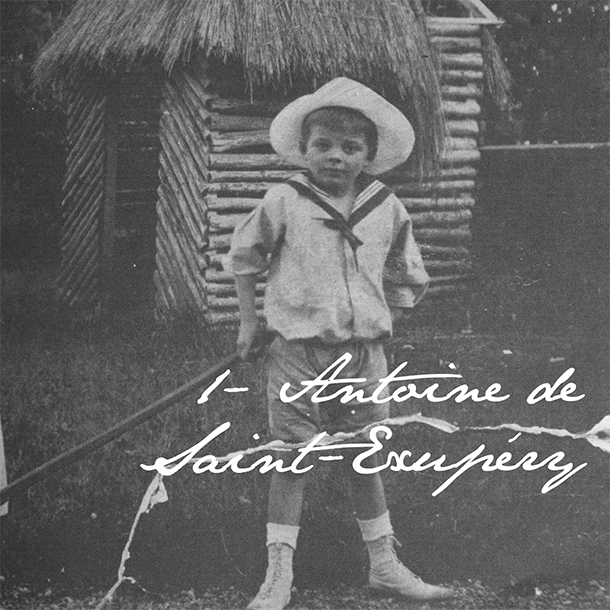
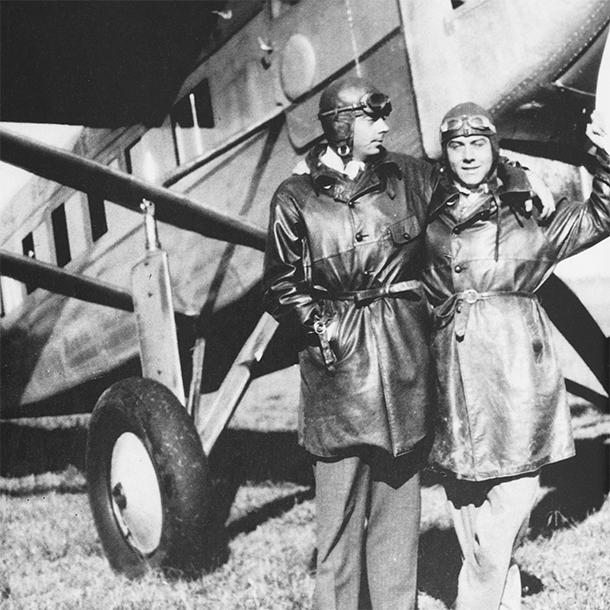
Saint-Exupéry was later on transferred to Buenos Aires in Argentina where he worked as director of the Aeroposta Argentina airline, surveying for new night air routes between Buenos Aires and Punta Arenas (the capital city of Chile’s southernmost region).
Saint-Exupéry’s work experience is diverse. He used to work as an accountant, a truck salesman, a journalist and a war journalist. What he was most fascinated with, however, is being a pilot. He had several plane accidents. During World War II, he was engaged in teaching flying techniques, and somehow managed to fly with the surveillance team.
It is said that Saint-Exupéry wrote The Little Prince to alleviate his stress while taking a refuge in the US. There he had only few friends and the political conflicts among the immigrant French were taking place (some say The Little Prince reflects the author as a royalist).
The Little Prince closely relates to different stages of Saint-Exupéry’s life experience. His familiar African deserts, the plane crashes, the number B612 for the aircraft he used to ride, a pond at his home in Lyon, the volcano in Chile-Argentina, the baobab trees in Dakar, Senegal. Although New York city was not mentioned in the book, America and France was referred to in the chapter that talks about sunset.
Saint-Exupéry liked to draw pictures on letters, notebooks, table cloths in restaurants. Sometimes he drew the little prince as himself. He once wrote a letter to a woman and began the conversation with a picture of the little prince holding a flower saying ‘sorry to bother you. I just want to say hello’.
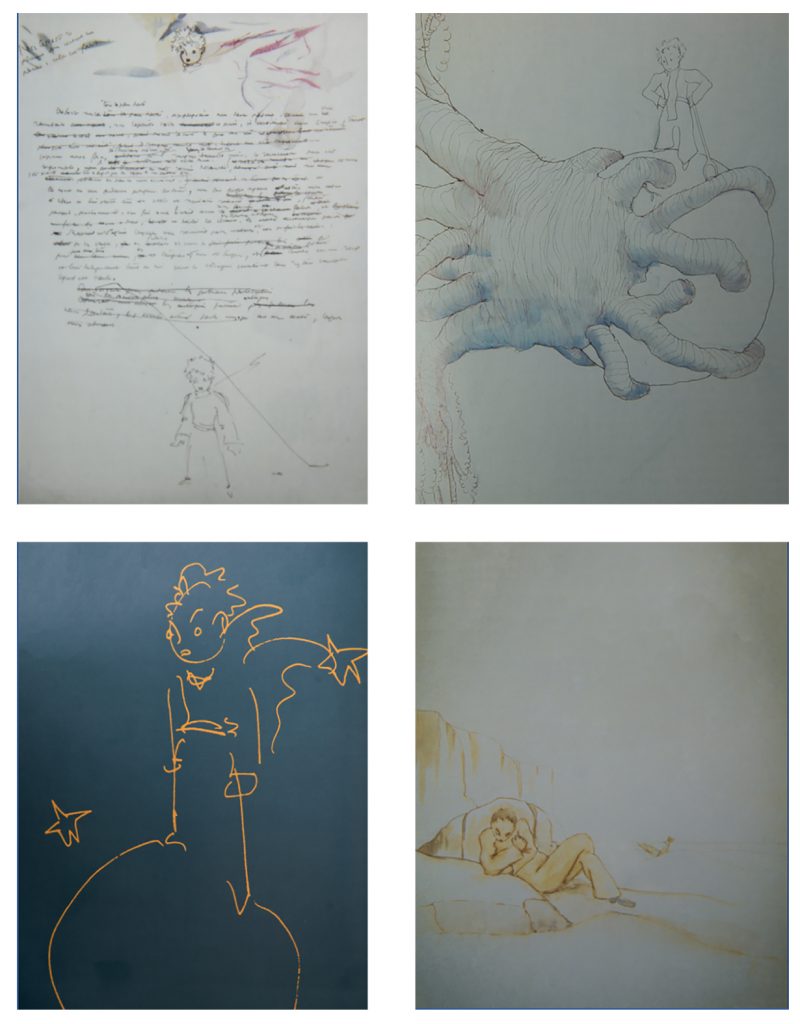
Someone remarked that ‘a picture of an innocent child with a sad smile, a scarf fluttered by the wind, alone under wide sky, makes one think of the sorrow behind the drawer’s mind. It is possible that the drawer was dreaming of a son which he did not have or that he wished for this childhood to last forever’.
On 31 July 1944 at 08.55 hrs., Saint-Exupéry took off an aircraft from an airbase on Corsica for his reconnaissance mission south of France. At 14.30 hrs., a report confirmed the disappearance of the aircraft. That year he was 44 years old.
In 1998, a fisherman found Saint-Exupéry’s bracelet in the fishnet outside the shore of Marseille.
In 2004, the French government confirmed the discovery of the aircraft in which Saint-Exupéry took off for his last reconnaissance mission in the area around an island south of Marseille. As for the claim made in 2008 that the aircraft was shot down by German troops, so far there has been no evidence.
There is a striking resemblance between the final episode of the The Little Prince and that of the author.
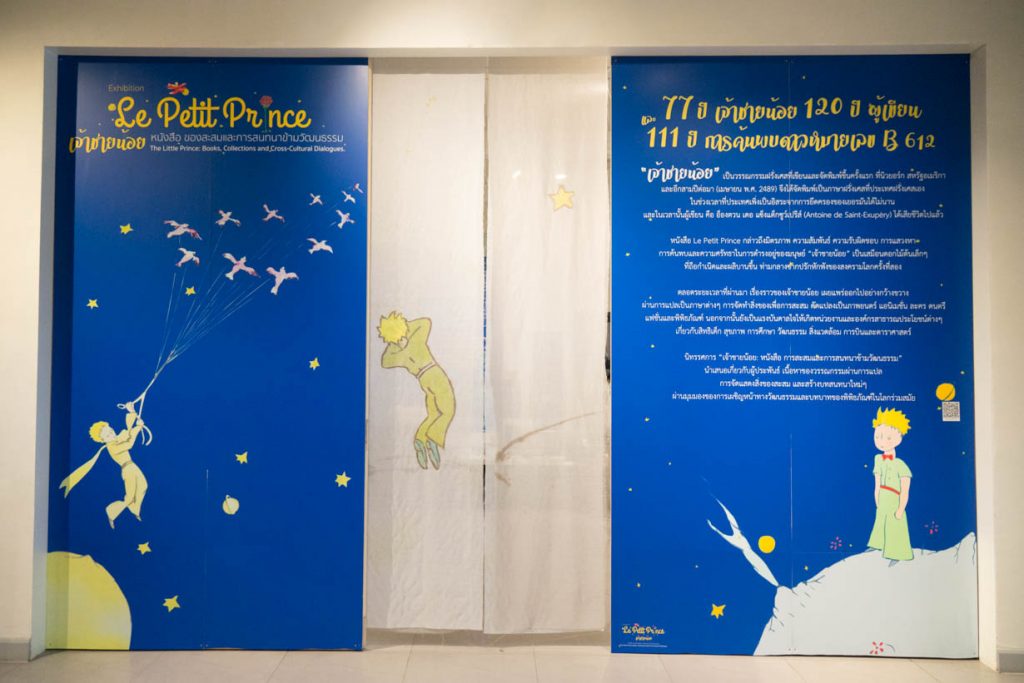
‘You understand… it is too far. I cannot carry this body with me. It is too heavy.’
‘But it will be like an old abandoned shell. There is nothing sad about old shells…’
There was nothing but a flash of yellow close to his ankle. He remained motionless for a little while, without crying out. Slowly he started to fall onto the ground as gently as a falling tree. There was not even a tiniest sound.’
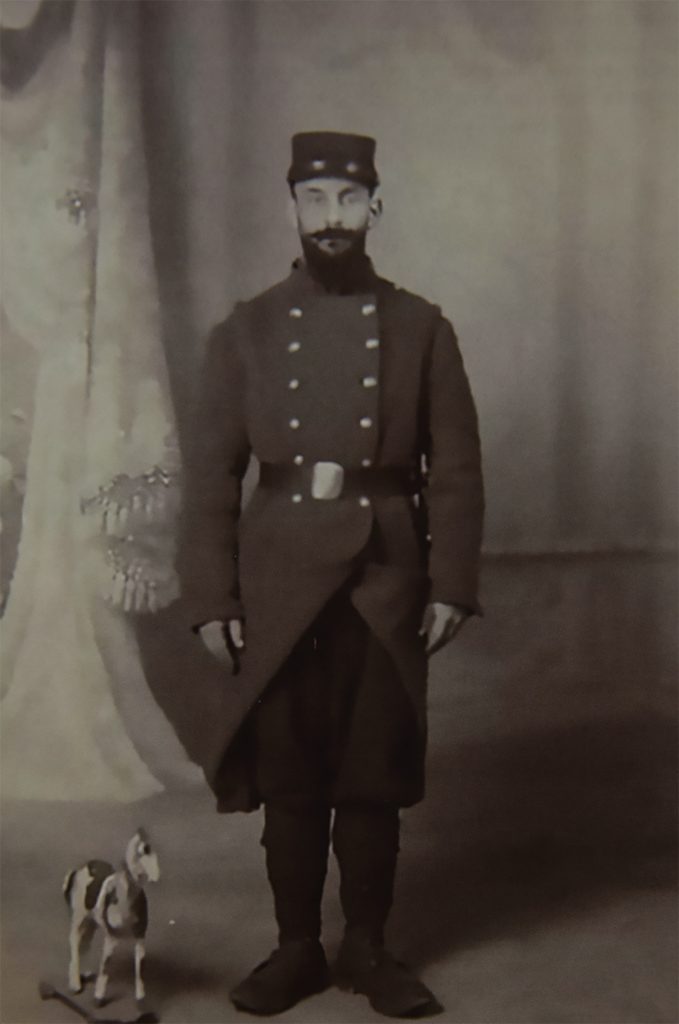
TO LEON WERTH
I ask the indulgence of the children who may read this book for dedicating it to a grown-up. I have a serious reason: he is the best friend I have in the world. I have another reason: this grown-up understands everything, even books about children. I have a third reason: he lives in France where he is hungry and cold. He needs cheering up. If all these reasons are not enough, I will dedicate the book to the child from whom this grown-up grew. All grown-ups were once children – although few of them remember it. And so I correct my dedication:
TO LEON WERTH WHEN HE WAS A LITTLE BOY
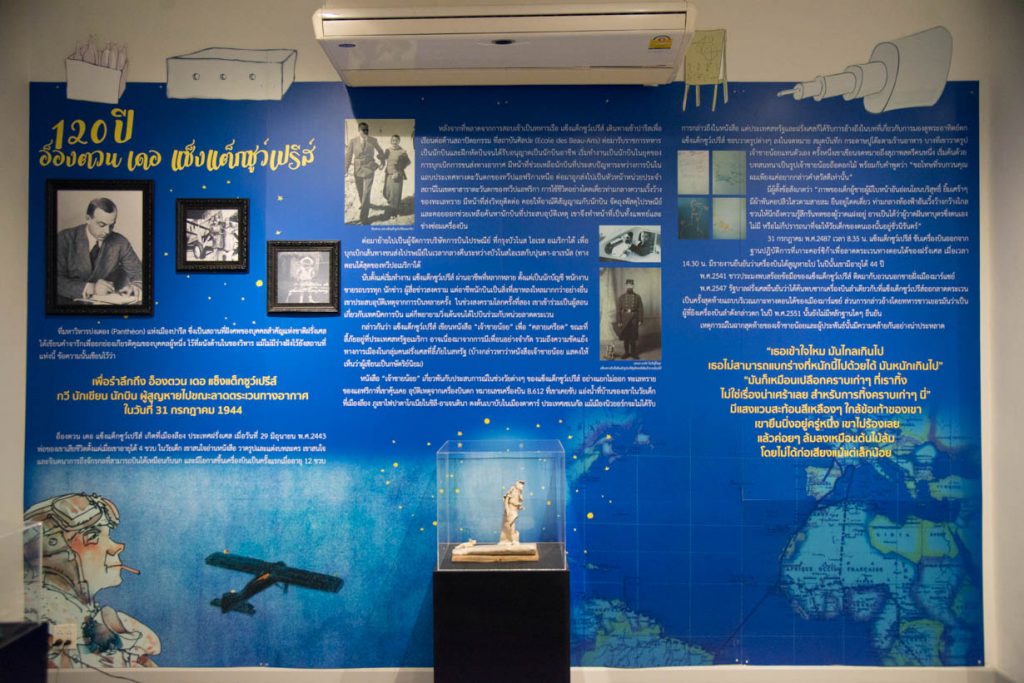
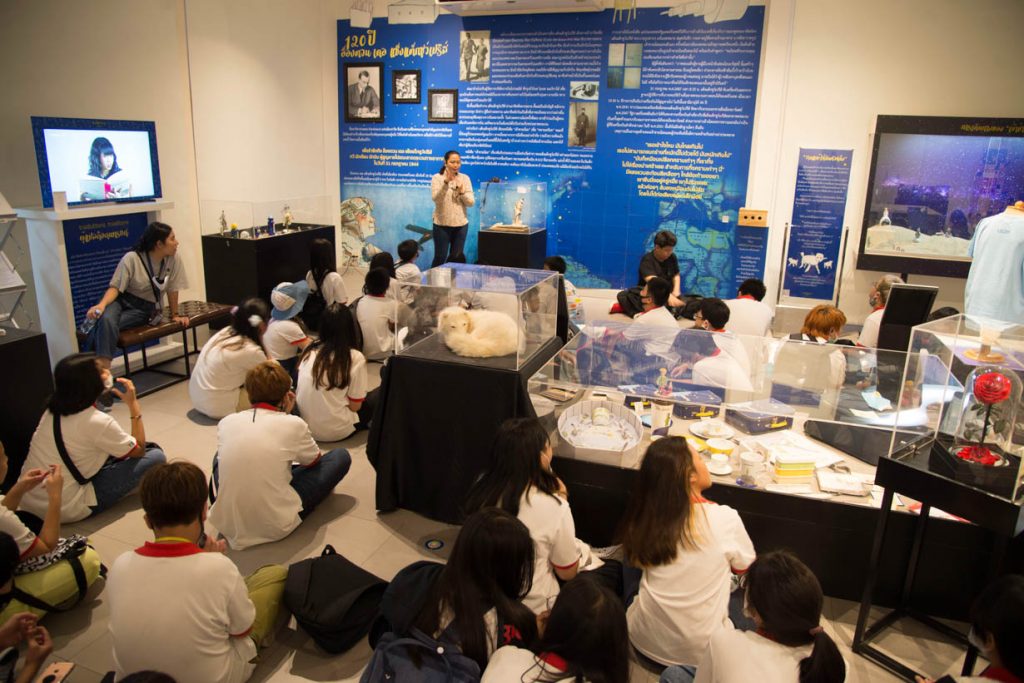
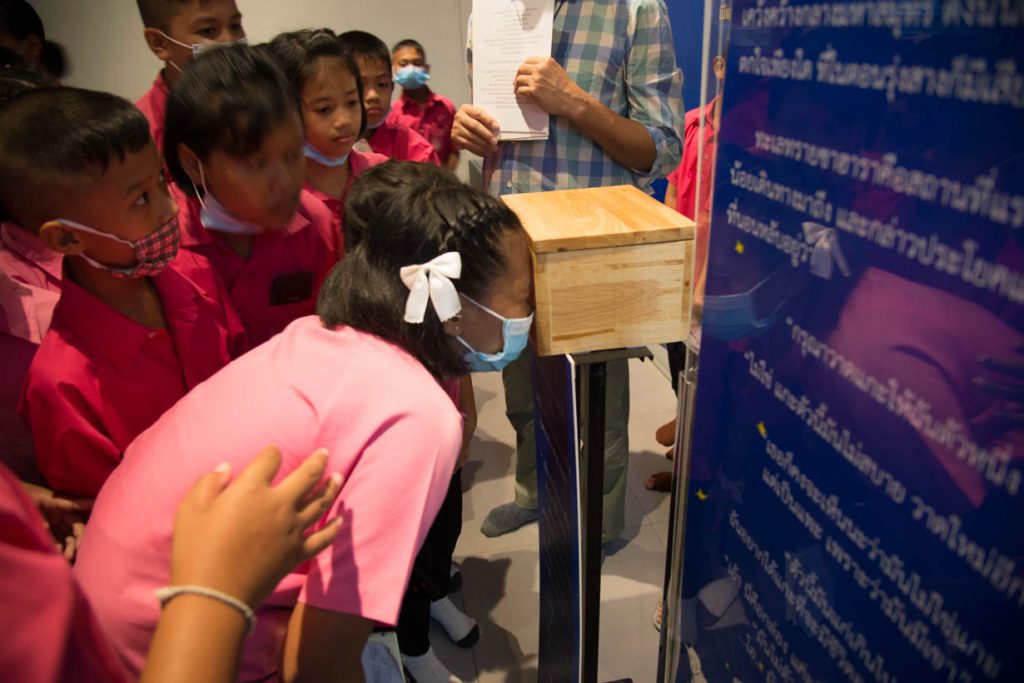
111 years of the discovery of planet B612: a cross-cultural dialogue
‘I have reliable reasons to believe that the planet from where the little prince came is planet B612. It is the planet discovered through a telescope by a Turkish astronomer in 1909. The astronomer presented his discovery to the international assembly of astronomy but no one believed him, only because his attire was odd. Grown-ups are like this. It was fortunate for this planet, however, that later on a Turkish dictator ordered that all Turkish people were to dress like Europeans, and anyone objecting this command would be executed. The astronomer presented his discovery again in 1920, when he dressed elegantly in European attire. This time everybody believed him.’(The Little Prince, Chapter 4)
This is the only episode in The Little Prince that the author stated specific years and places. Looking at the history of Turkey, the year 1909 was a year after the Young Turk Revolution, which later on resulted in the dissolution of the Sultanate system.
In 1920, the Russian Bolsheviks gained a victory in the civil war. Three years later, Mustafa Kemal (Atatürk), a Turkish field marshal and a nationalist, proclaimed the foundation of the Republic of Turkey on 29 October 1923, marking the transition from the Ottoman Empire to the Republic. The leader of the state aimed to promote the Turkish nationalism rather than holding an Islamic identity by banning the use of Arabic-Persian alphabets and sending mandate for all Turkish men to wear western-style hats instead of head cloths or traditional hats (fez).
The Little Prince was born out of the author’s personal memories. The little prince’s travels from one planet to the other is an ideological encountering and a cross-cultural dialogue between children and adults, east and west, and colonial and indigenous people.
The little prince, who is ‘too naïve to know love’, travelled from his planet in search for some answers and insights. The people whom he met were the king of planet 325, a conceited man, a drunkard, a businessman, a lamp lighter and a geographer on planet 330 who suggested to the little prince ‘go to planet earth. It is very famous.’
Earth was the seventh planet which the little prince visited. It is the last place he visited during his journey before returning to his little planet with the secret the fox gave him. Although earth is a planet which has 111 kings altogether (including the Negro king), together with a geographer, a businessman, a drunkard and so on, it is the place where different kinds of people which the little prince had met are together. It is here on planet earth that the little prince learnt about friendship, simple happiness, seeing things through his heart, discovery of a hidden beauty, responsibility in relationships, and love for mankind.
The desert and Africa are two important scenes in Saint-Exupéry’s life. The plane accident in December 1935 caused an emergency landing on an open desert in the borderland between Libya and Egypt. He and his co-pilot had to walk under the burning sun for days in search for drinking water. Finally, they were rescued by the Bedouin who came to them in just the same way the little prince did.
The encounter between Saint-Exupéry and the indigenous Bedouin gained him an awareness on humanity. But does the world in which Saint-Exupéry lived and by which we all are abided see humans in the same way Saint-Exupéry did?

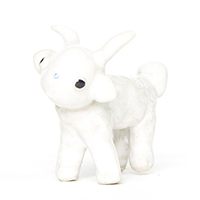









“I have also a flower.” “We do not record flowers,” said the geographer. “Why is that? The flower is the most beautiful thing on my planet!” “We do not record them,” said the geographer, “because they are ephemeral.”
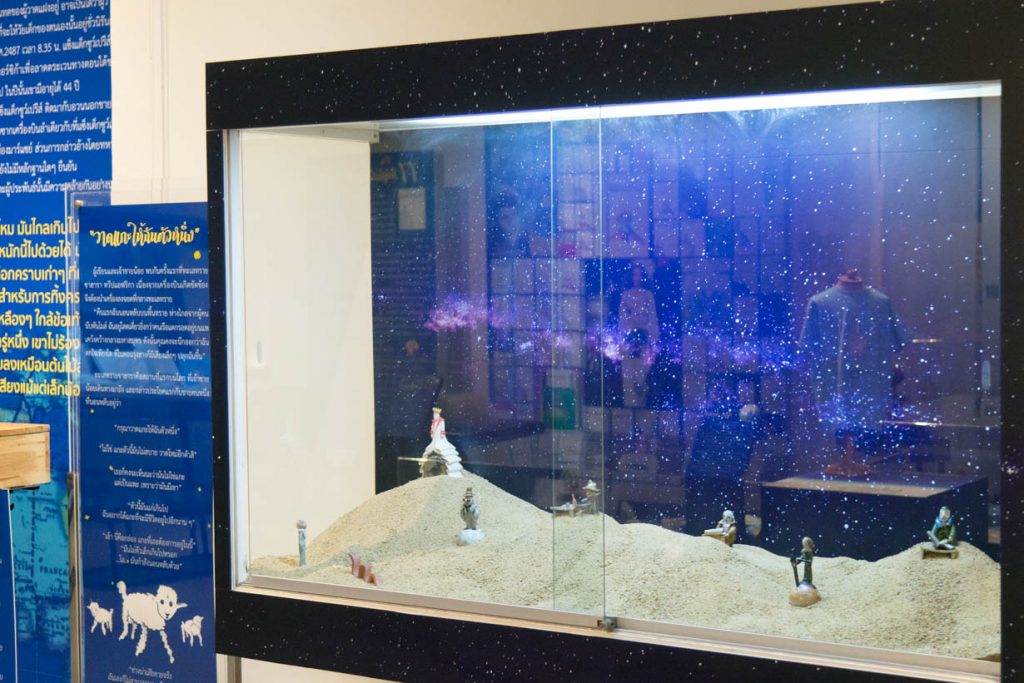
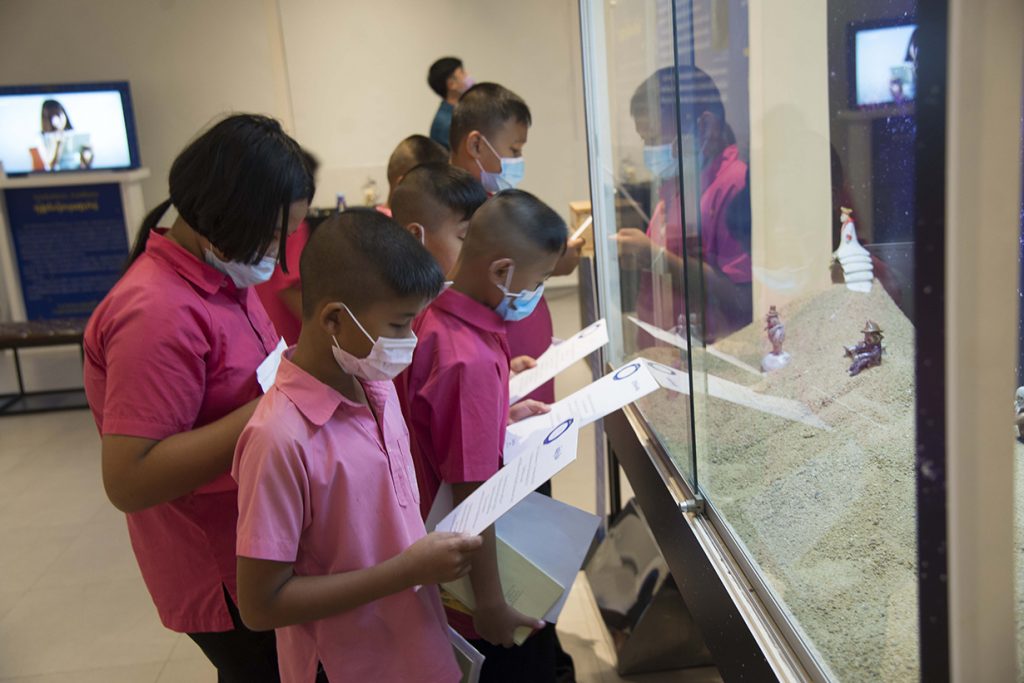
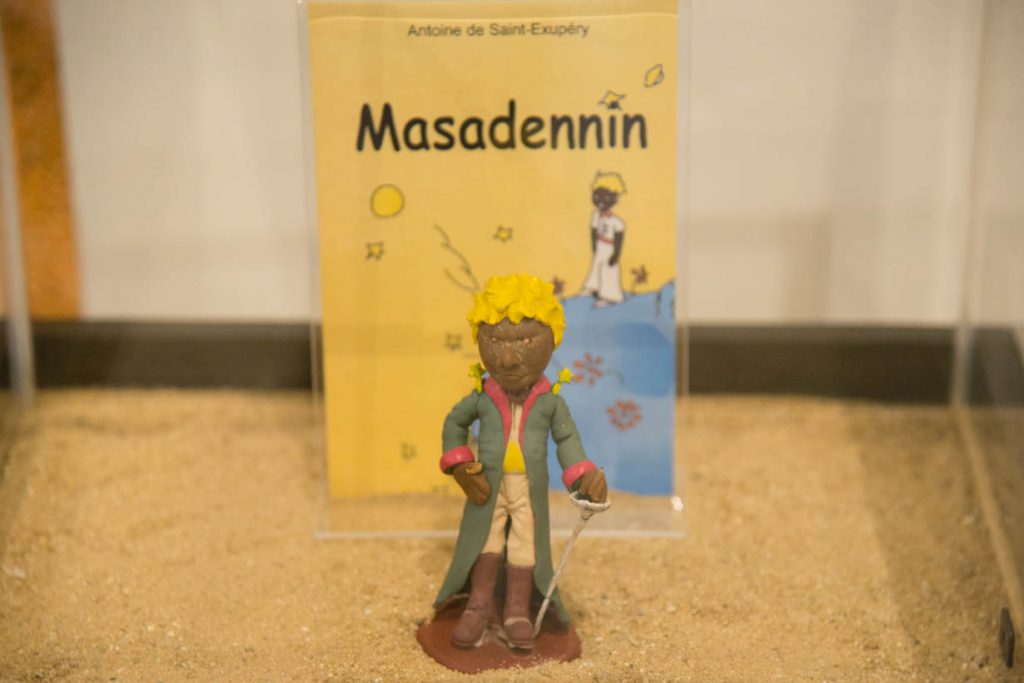
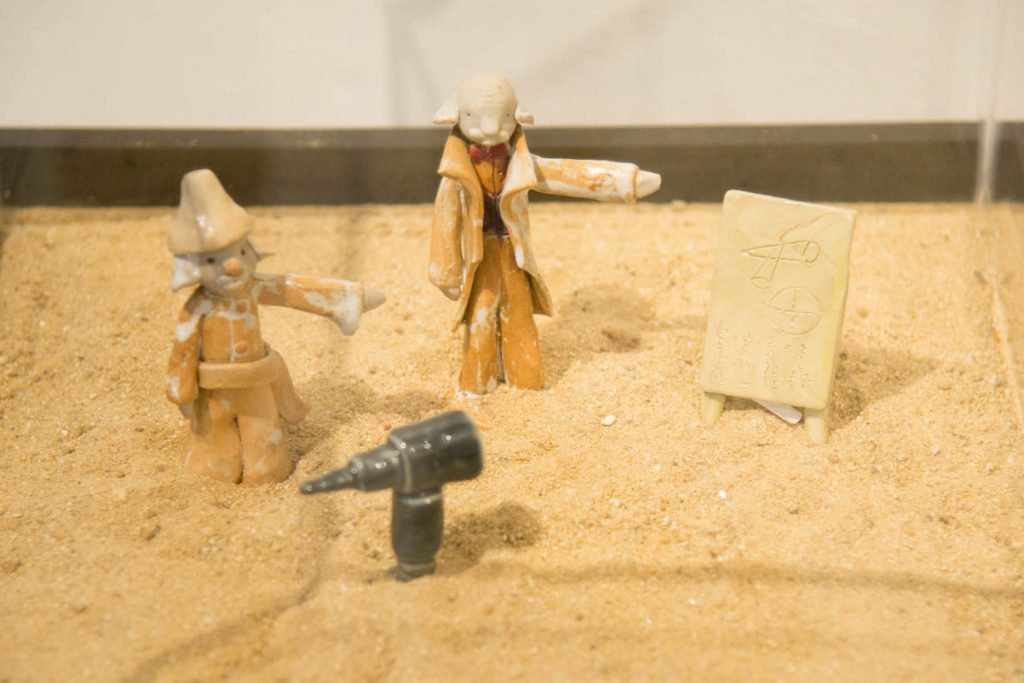
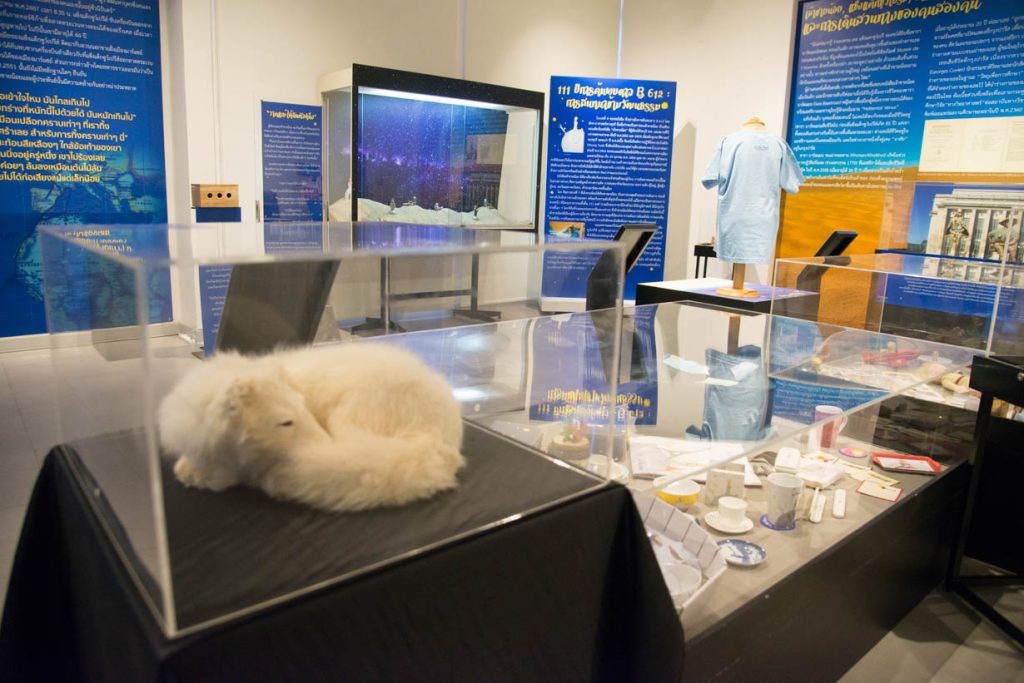
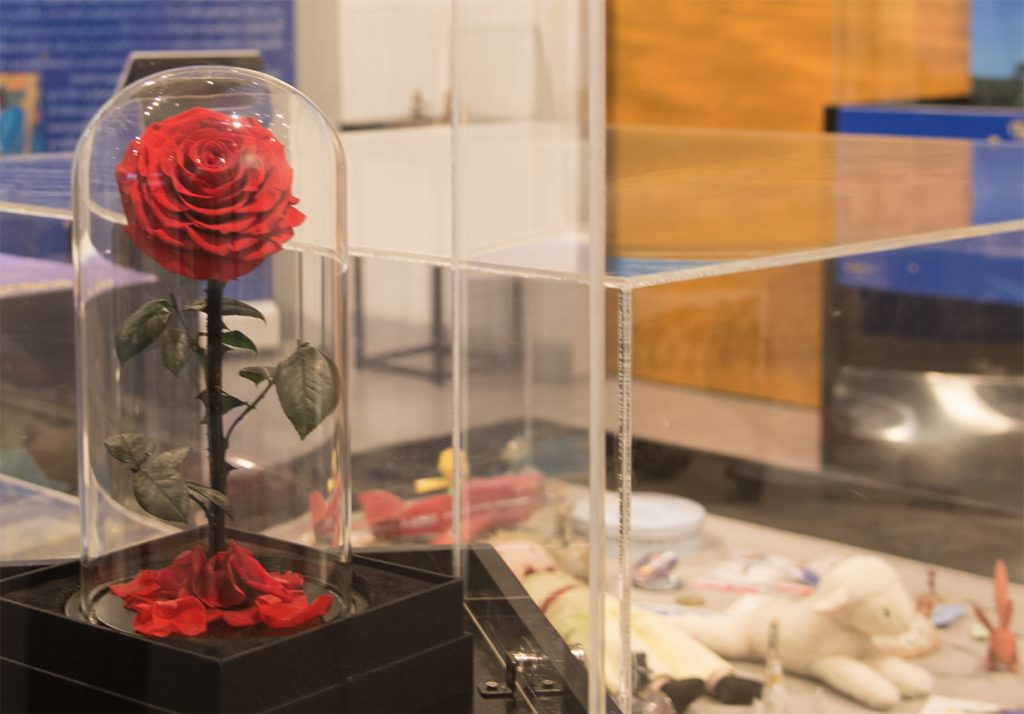
The Little Prince, Saint-Exupéry, Sara Baartman and a cross over between two people
‘I just want to know if Antoine Saint-Exupéry has heard of Sara Baartman. I wonder if, in his childhood, he ever saw some of her body parts (such as brain and vagina) which were cut off and preserved in jars at Museé de l’Homme? What would he say seeing those body parts? Would he be so curious and asked adults about such body parts like the little prince did when he asked the pilot and those whom he met on each planet?’
A reader remarked. She used to admire The Little Prince in his childhood. Several decades after, she became to know about the life of Sara Baartman, an indigenous woman from southern Africa known by the Europeans as ‘Hottentot Venus’.
In fact, these two people never met in their lifetime (Sara Baartman died 85 years before Saint-Exupéry was born) but they crossed over each other in time and space. Both used to live in Africa and France, and for some time ‘stay’ in Paris.
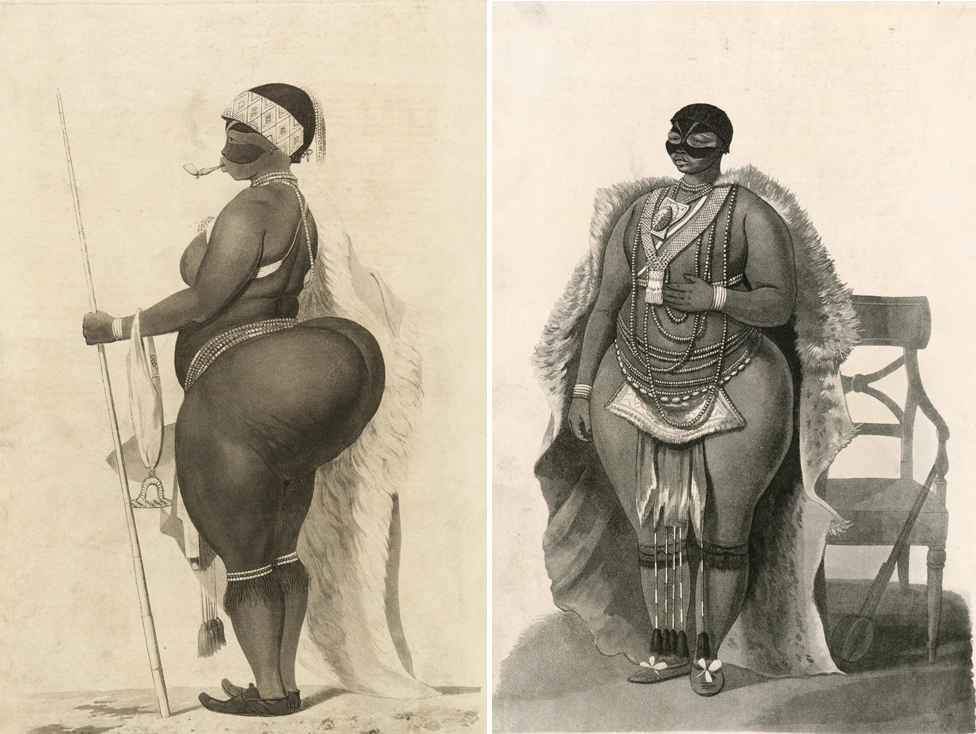
Sara Baartman, a member of Khoisan/Khoikhoi tribe, was born during the French Revolution (in the 1770s) in South Africa and died in Paris in 1815 (aged 26?). Being an orphan, she was a slave working in a farm owned by a Dutch man. When about 20 years old, she was taken to England on a ship by a Scottish doctor and a circus owner. She was then ‘sold’ to the French man who was a circus owner and animal trainer who at the time had a show in Paris. She was bought for the show which exhibited exotic people, animals, and objects from Africa. With her wide hips which are usual among the people of her tribe, the European audiences called her ‘Hottentot Venus’.
She became ill in 1814 and died in Paris the following year. George Cuvier, France’s eminent naturalist and zoologist, was very much interested in her body as being an ‘educational object’ for human evolution. Having casted her body, Cuvier dissected body and preserved her brain and vagina in jars. He boiled the remaining fresh of her body in order to remove them from the bones so as to preserve the latter. Cuvier presented the result from his ‘scientific’ research to a prestigious academic institution in Paris and published his work in 1817. His publication was titled ‘Some remarks on the body of a famous woman in Paris and London known as Hottentot Venus’. His study shows that her body resembles more to apes than human.
Her skeletons, brain, vagina, as well as cast naked body was on display at Musée de l’Homme in Paris from 1827. In 1974, her preserved brain and vagina were removed from the display room, but her cast body continued on display for many years after.
Saint-Exupéry came to Paris to study art when he was 19 (in 1919). After his study, he stayed on in Paris for some time and worked in different fields. During that time, Baartman’s cast body and her other things in the name of ‘Hottentot Venus’ were still on display at Musée de l’Homme in Trocadéro area in Paris.
However, as a reader has remarked, did Saint-Exupéry ever visit the Museum or hear of Sara Baartman?
If he ever did, what would he have thought?
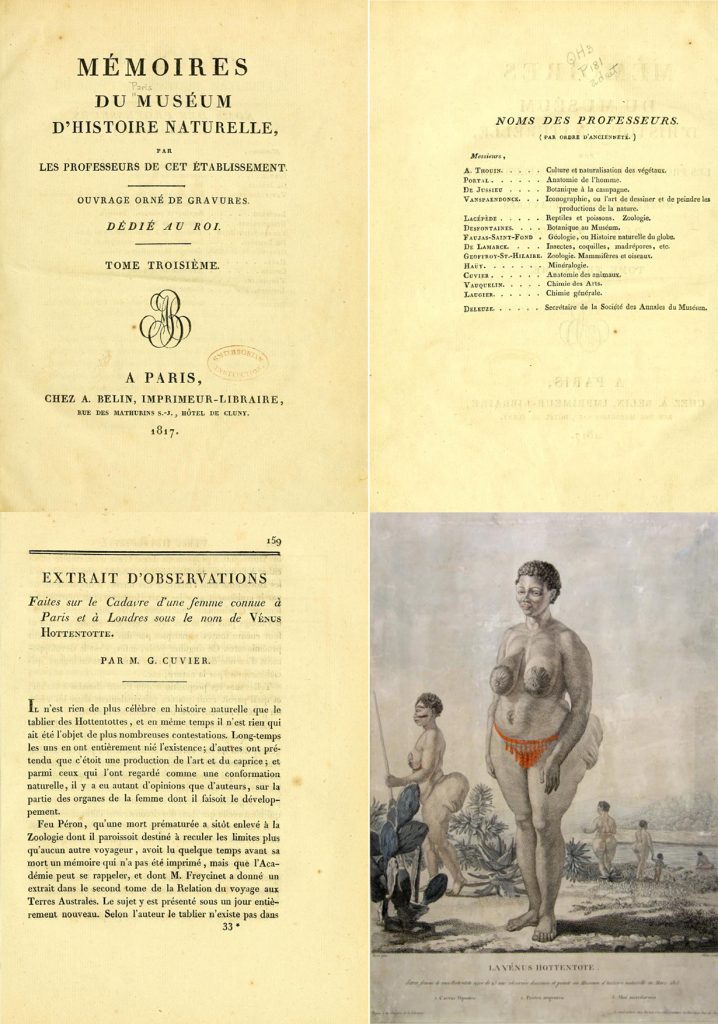
The First Encounter: The Little Prince and Sara Baartman
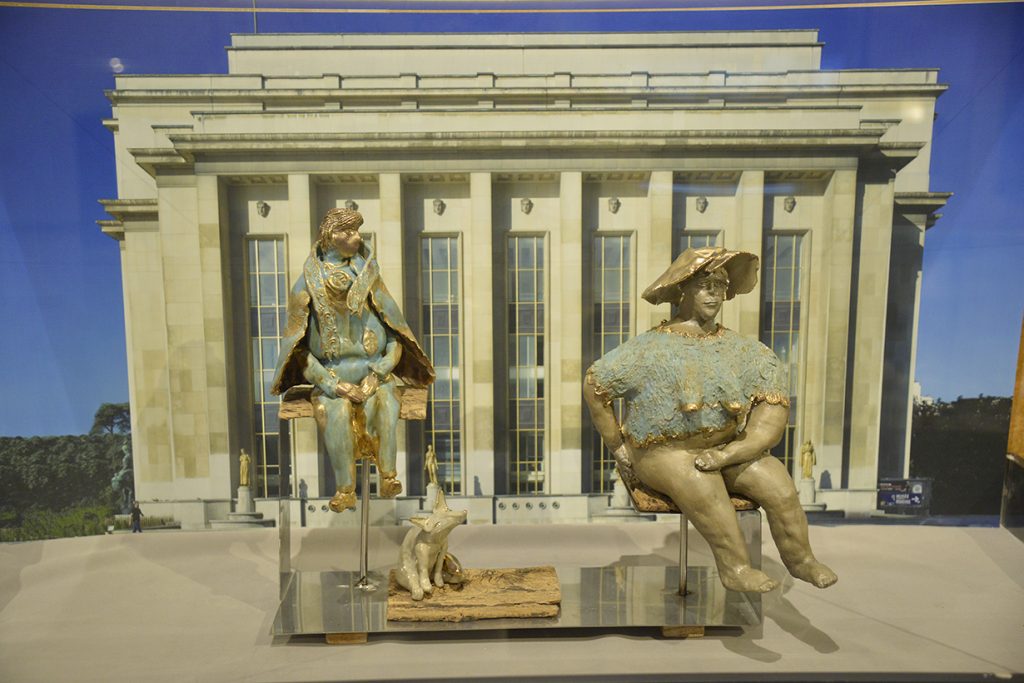
When you look at this artwork, please do not look for aesthetics or ‘correctness’ in art, but at ideas, for the artist is only a local ceramist who has no official training in art whatsoever.
The ceramist thinks that ‘The Little Prince’ should be a little younger so as to fit with this era: the era which has changed from the day the book was composed. Also, as we now live in a modern world, the base (or the support of the sculpture?) is made in stainless steel rather than clay.
Coloured people, whose colour is in their DNA, do not change the way they look. While their appearance remains unchanged, their thoughts, civilization and pride pertain. This is in the same way as the Chinese, whose appearance remain Chinese however much they become richer.
In modern world, coloured people also have pride. Gilding (adding gold) in this artwork has an objective as to make the sculpture glow like glorious westerners. With the way they look, African people can also prosper like others too. Africa is an important land for gold mining.
This artwork has ‘The Little Prince’ facing in conversation with Sara Baartman, who although engages in the conversation, has her face slightly turned to the side as if she does not really care. Well, she has her pride. Whatever you want to ask her, ask. She will of course answer your questions, but let her pretend she is not really listening and that she is a little arrogant.
Sara Baartman
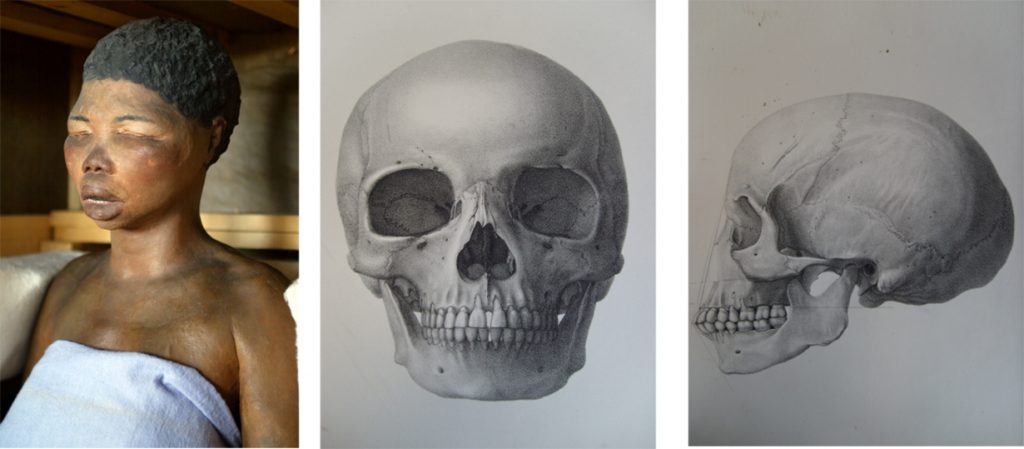
Since 1940, there has been attempts by the people in Sara Baartman’s hometown to bring back her ‘remains’ to be buried in South Africa. After years of negotiating with the French authorities, her remains were finally brought back to her birthplace in 2002. It took almost 200 years before her remains could be brought back to peace after Baartman had been brought away from her hometown.
Here, races, languages and discrimination do not exist…There is only a poor nomad in a desert who has placed God’s hand on our shoulders…Bedouin of Libya. You who saved our lives…You are ‘Humanity’. Your face, in my memory, is a face of all mankind…I will know you in every human. In my imagination, you are superior, benevolent, and a mighty man who gives us water…All my friends and enemies have now here entered. I have not a single enemy left in this world.’
(Terre des Hommes / Wind, Sand, and Stars: Antoine de saint-exupéry)

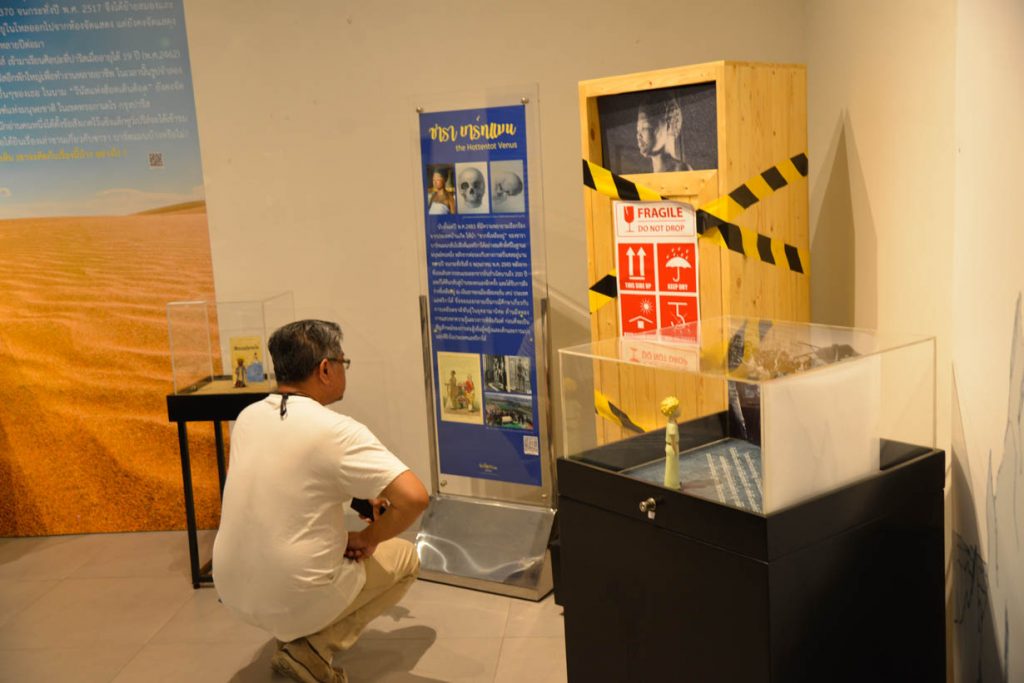
6 October 1976 massacre
‘It seemed that on the little prince’s planet, as on all planets, there were good plants and bad plants. Good seeds come from good plants and bad seeds come from bad plants. But seeds are invisible. They remain dormant in the depth of the earth until one of them was overshadowed by a desire to wake up.’ (The Little Prince, Chapter 5).
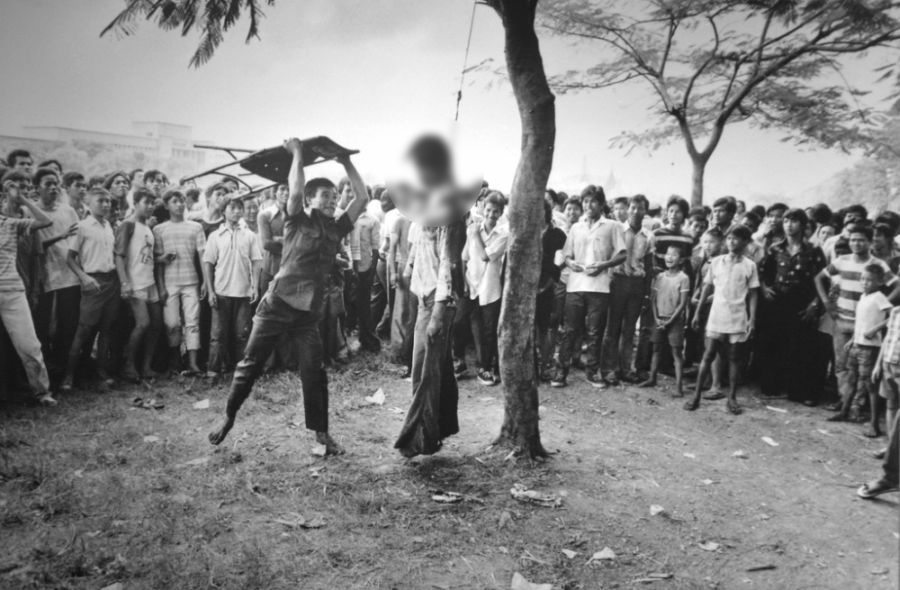
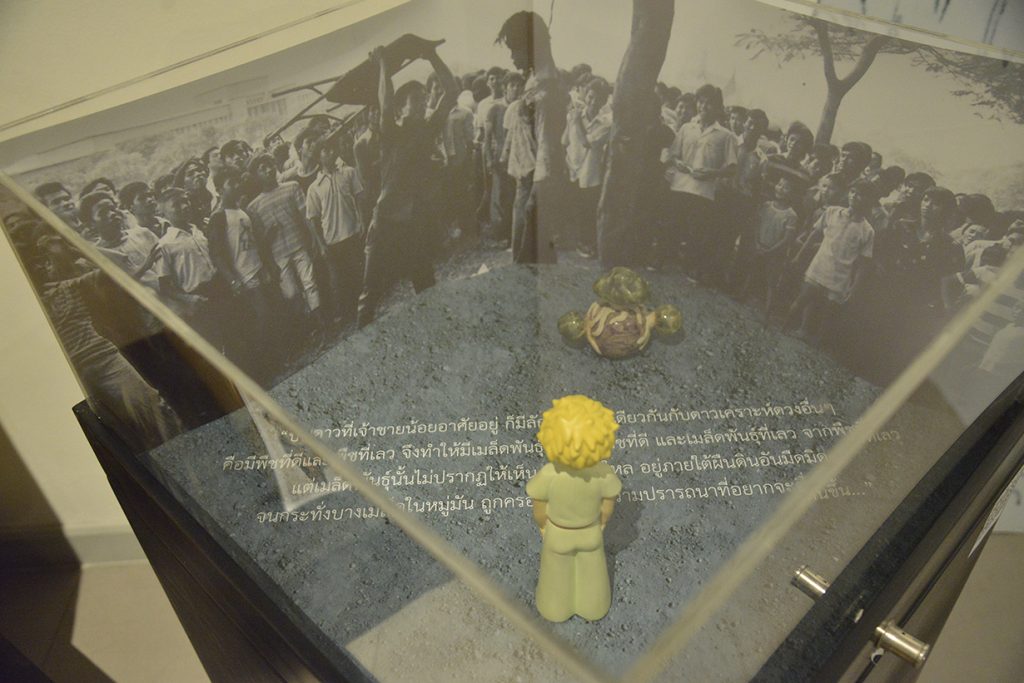
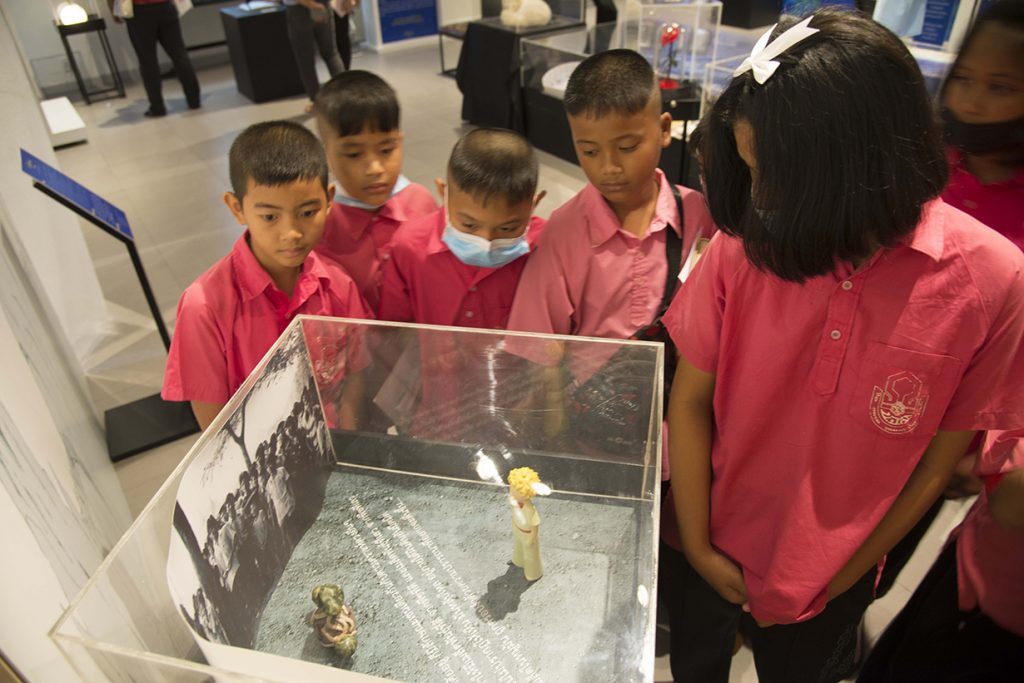
The Collectors
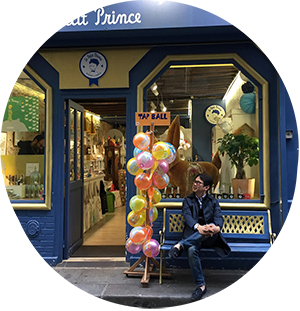
Kongchalatch Kreawy
‘I began reading the book in Thai when I was in my high school. I was then fascinated by the way the author presented the philosophy that could be interpreted in different ways. Overall, I believe in the positive thinking of the little prince. I have applied some thoughts in the book into my life, as well as into my research which involves human and my running of a restaurant which pays much attention to providing good service to different kinds of people. Visiting The Little Prince shop in France is my dream. And that dream came true two years ago.’
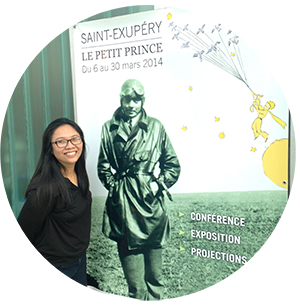
Nuttorn Vanichakorn
‘I started from enjoying reading The Little Prince. After having seen the little prince on objects, I became one of his fans. His cuteness is hard to resist. The Little Prince coffee mug was, if I remember correctly, the first object of my collection….Then I began to collect all kinds of the little prince’s items, as far as I could afford. Now with those new products on the French and Japanese (and other) websites…I bought too many that I can hardly find where to keep them. The worse thing is I don’t want to use them. I only keep them in drawers or cases. The Japanese and Korean versions, for example, offer a variety of book cover, and I often travel to these two countries. Whenever the new version of book cover becomes available, I end up buying them. This habit of mine has become widely known among friends, who often buy me The Little Prince when they travel. I have now become more careful because each item of The Little Prince is not at all cheap (#but they are essential). What I continue to acquire are different translations of The Little Prince. Those who visit places of unfamiliar language usually bring me the translated version of The Little Prince in that language.
So I got these items of The Little Prince by going to places where I could buy them in person, as well as ordering them from the web and asking friends to get them for me. I once asked a senior friend to get me the little prince’s lamp from a shop in France. When I collected the lamp at the airport, it was a monk who gave me that lamp. My friend had asked him to bring it back to me!

Piyalak Nakayodhin
‘The Little Prince is not only a literature whose content invites one to read again, but also a book whose illustrations are adorable and impressive. Even those who has never known the little prince can easily fall in love with it, needless to say how exciting it can be for those who have read the book several time?
When the little prince unexpectedly turned up in a book stall in the garden surrounding Avecinna Square in Hamadan, western Iran, I then got myself The Little Prince in Farsi version. When I visited the Science Museum at Science Hills Komatsu in Ishikawa Prefecture, Japan, it was unbelievably incidental that their dome-shaped 3D theatre was showing The Little Prince animation (in Japanese) in 4K resolution.
On searching for postcards at a convenient store inside a train station in Switzerland, I did not manage to get one but instead I got myself several postcards of the little prince with clever quotes in German. When I visited The Little Prince Museum in Hakone, I was determined to stay in a Ryokan near the museum for three days. That way I was able to pop around to see the light that cast upon the face of the little prince’s statue during different times of the day (excluding the times I popped inside the souvenir shop ;)).
There was another time when I woke up early to get on a train from Zurich, crossing the Swiss and German borders, to Mulhouse in Alsace region, France, before getting on a cab to visit the little prince theme park (Le Parc du Petit Prince, Ungersheim). I was there the whole day, from 10am through to 6pm. However, the most incidental event was when I visited Panthéon in Quartier Latin, Paris, 20 years ago. Having walked around the place for some time, I became tried and so sat down in front of the entrance for some rest. Then my eyes stumbled upon an engraving on the wall, which says ‘In memory of Antoine de Saint-Exupéry, poet, writer, and pilot who disappeared during his reconnaissance mission on the 31st July 1944’.
‘Actually, I don’t have a big collection. I think they are things, places and events of different kinds that brought us together with what we are bound to. Perhaps this is like what the pilot said to the little prince ‘what makes things beautiful are those which we cannot see’.
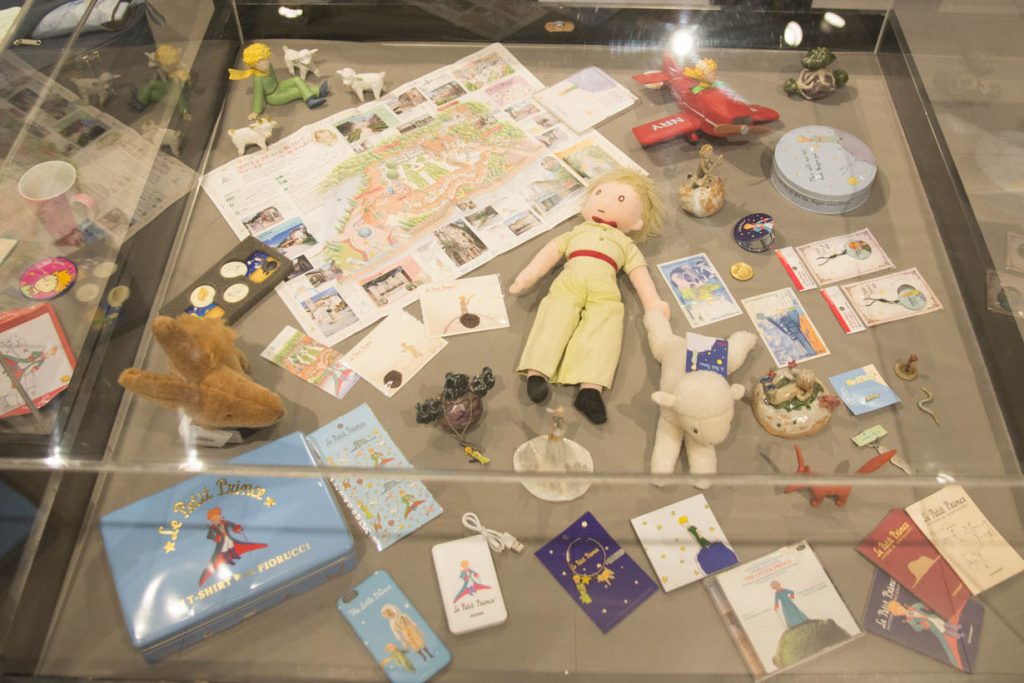
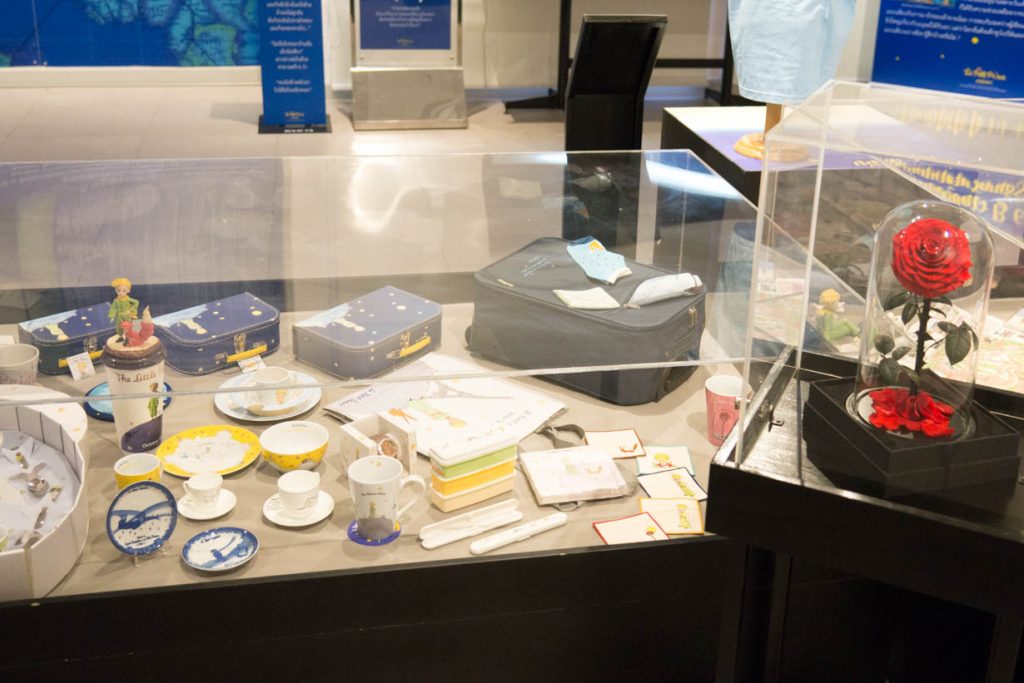
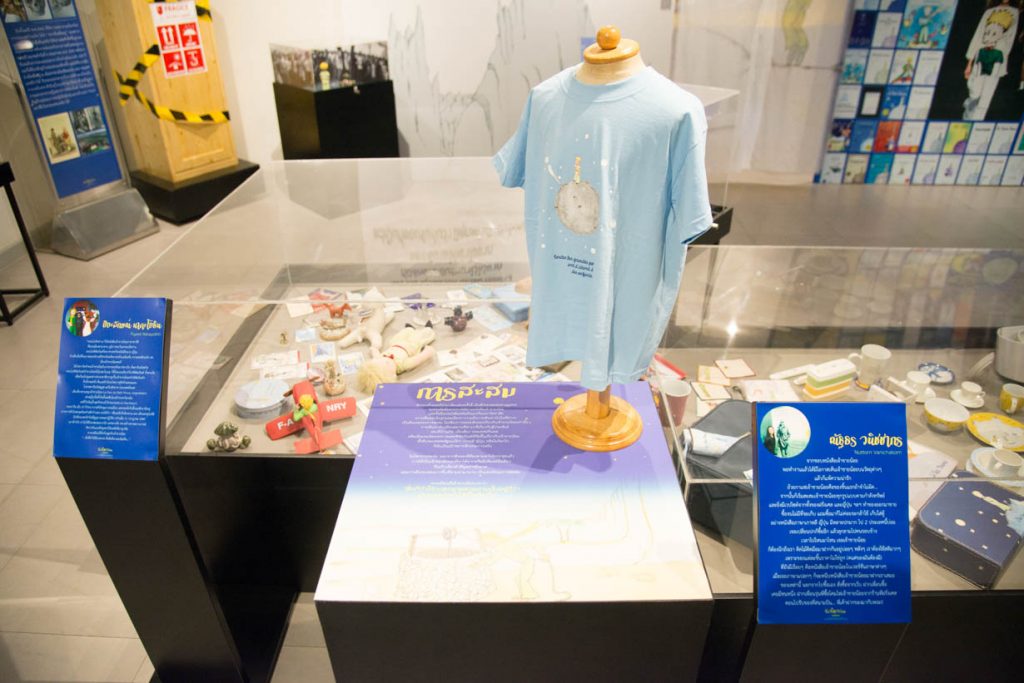
References
จุฑารัตน์ เบญจฤทธิ์ , “เจ้าชายน้อย (Le Petit Prince): ภาพสะท้อนของผู้ประพันธ์ อองตวน เดอ แซงเต็กซูเปรี” วารสารอักษรศาสตร์ มหาวิทยาลัยศิลปากร ปีที่ 31 (2552) ฉบับที่ 1 หน้า 115-135
แฌแมน เบร-มากาเร็ต ไกตัน “อังตวน เดอ แซงเตก ซูเปรี” แปลโดย สดชื่น ชัยประสาธน์ ใน 100 ปี แซงเตก-ซูเปรี. เรืองกิตติ์ รักกาญจนันท์ (บรรณาธิการรวบรวม) จัดทำโดย กลุ่มใบไม้ป่าร่วมกับ ภาควิชาวรรณคดี คณะมนุษยศาสตร์ มหาวิทยาลัยเกษตรศาสตร์, 2543
นอร์แมน สโตน, ประวัติศาสตร์ตุรกี (ชาครีย์นรทิพย์ เสวิกุล แปลจาก Turkey A Short History) กรุงเทพ : ยิปซี กรุ๊ป, 2562
เบเนดิก แอนเดอสัน, “กิจการเดินสาร-ข้ามผ่านภาษา : ว่าด้วยภูมิ-ชีวประวัติของ “ชุมชนจินตกรรม” ใน ชุมชนจินตกรรม บทสะท้อนว่าด้วยกำเนิดและการแพร่ขยายของชาตินิยม (ชาญวิทย์ เกษตรศิริ บรรณาธิการแปล) กรุงเทพ: เคล็ดไทย, 2552
วัลยา วิวัฒน์ศร, “จากแผ่นดินของเรา สู่เจ้าชายน้อย” ใน นิตยสารไรเตอร์ ปีที่ 2 ฉบับที่ 20 มกราคม 2537
สายคำ ผกาย, “วิญญาณที่หยุดบิน แซงเต็กซูเปรีในนิวยอร์ก” แปลเรียบเรียงจาก “ A Grounded Soul : Saint-Exupéry in New York.” โดย Stacy Schiff จาก The New York Time Book Review. May 30,1993. นิตยสารไรเตอร์ ปีที่ 7 ฉบับที่ 1 (56) มกราคม 2541
อองตวน เดอ แซงเตก-ซูเปรี, เจ้าชายน้อย (แปลโดย อำพรรณ โอตระกูล) ฉบับครบรอบ 60 ปี. กรุงเทพ : เรือนปัญญา, 2546
Antoine de Saint-Exupéry. The Little Prince. Translated by Ros and Chloe Schwertz. Macmillan Collector’s Library, 2016
Antoine de Saint-Exupéry. Le Petit Prince. Gallimard, 1994
Christophe Quillien. The Little Prince A Visual Dictionary. Cernunnos, 2016
David Bindman. “Sara Baartman” in Between worlds Voyagers to Britain 1700-1850. National Protrait Gallery, 2007 pp.89-95
Georges Cuvier, Extrait d’observations faite sur le cadavre d’une femme connue à Paris et à Londres sous le nom de Vénus Hottentotte,1817
Justin Pearce. “Hope of Saartjie’s return won’t die. in http://web.mit.edu/racescience/in_media/baartman/baartman_m&g_movement.htm
Susan Firth. “Searching for Sara Baartman” Johns Hopkins Magazine in https://pages.jh.edu/~jhumag/0609web/sara.html
อองตวน แซงแตกซูเปรี / ซารา บาร์ตแมน : การเดินทางสวนทิศของคนผิวขาวกับผิวดำ
Thanks
ขวารี ผลดี, คงชลัช เครืออยู่, เคียง ชำนิ, ชาว สุภาจินดานนท์, ณัฐธร วนิชชากร, นิรมล มูนจินดา, น.สพ.ดร.บริพัตร ศิริอรุณรัตน์, ดร.ปริตตา เฉลิมเผ่า กออนันตกูล, ประภาศรี ดำสอาด, ปิยะลักษณ์ นาคะโยธิน, พันชนะ วัฒนเสถียร, ภารุจีร์ บุญชุ่ม, วรรณพร เรียนแจ้ง, วีรวุฒิ โอตระกูล, วัชระ สงวนสมบัติ, ศรุต บวรธีรภัค, ยรรยง อัครจินดานนท์, อนุรักษ์-เฉลิมเกียรติ บุญคง, อริยา ไพฑูรย์, อนัญญา ธรรมเกษร, อาทิตย์ วงษ์สง่า, เอกรัตน์ บุณยวัฒน์, Lattanaxay Vannasy, Benjamin Ivry, พิพิธภัณฑ์ธรรมชาติวิทยา องค์การพิพิธภัณฑ์วิทยาศาสตร์แห่งชาติ, นิตยสารสารคดี
Media
Still unlocking life’ mysteries: Bangkok Post https://www.bangkokpost.com/life/arts-and-entertainment/1981631/still-unlocking-lifes-mysteries?fbclid=IwAR28mAXqh2rJ7MOPaKWFF0nCtRBw8CPxkoIJ0LG72KmgJwLO_wD5hYTGeA8
The Cloud
https://readthecloud.co/the-little-prince-books-collections-and-cross-cultural-dialogues/
The Momentum
Text : Suddan Wisudthiluck
Translator : Wannaporn Rienjang
